#designer: matias paul
Text
If Joshua Picked the Oscars

Best Picture of The Year : Tár
For notable
Direction: Todd Field
Writing: Todd Field
Performance(s): Cate Blanchett, Nina Hoss, & Noémie Merlant
Cinematography: Florian Hoffmeister
Editing: Monika Willi

Best Director
WINNER: Moneyboys by C. B. Yi
RUNNERS-UP:
Charlotte Wells for Aftersun
Kristoffer Borgli for Sick of Myself
Jerzy Skolimowski for EO
Luca Guadagnino for Bones and All

Best Actor
WINNER: Eden Dambrine in Close
RUNNER UPs
Colin Farrell in After Yang
Cosmo Jarvis in It Is In Us All
Kai Ko in Moneyboys
Paul Mescal in Aftersun

Best Actress
WINNER: Kristine Thorpe in Sick of Myself
RUNNERS-UP
Kayije Kagame in Saint Omer
Guslagie Malanda in Saint Omer
Françoise Lebrun in Vortex
Mia Goth in Pearl
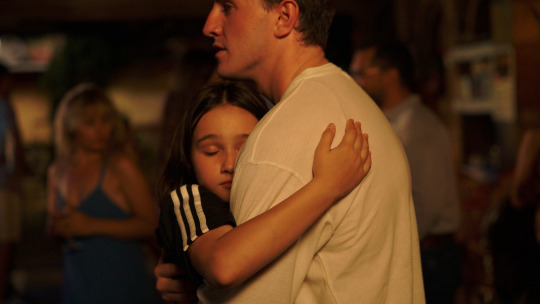
Best Original Screenplay
WINNER: Charlotte Wells for Aftersun
RUNNERS-UP:
Kristoffer Borgli for Sick of Myself
Saul Williams for Neptune Frost
C.B. Yi for Moneyboys
Laura Paredes & Laura Citarella for Trenque Lauquen
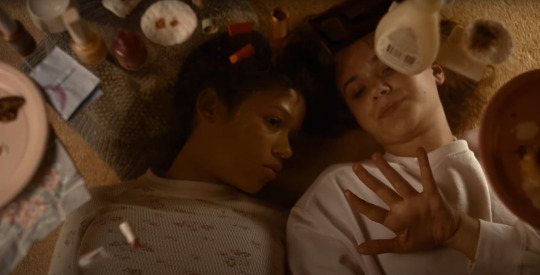
Best Adapted Screenplay
WINNER: David Kajganich for Bones and All
RUNNERS-UP:
Jerzy Skolimowski and Ewa Piaskowska for EO
Andrew Litvack, Léa Mysius, and Claire Denis for Stars at Noon
Kogonada for After Yang
Guillermo del Toro’s Pinocchio
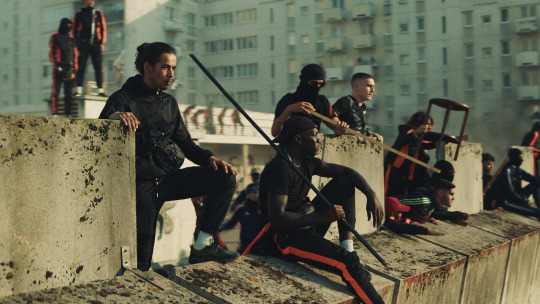
Best Score
WINNER: Athena by Benoit Heitz (GENER8ION)

Best Song of 2022 (Featured in a Movie)
WINNER: Stars at Noon by Tindersticks
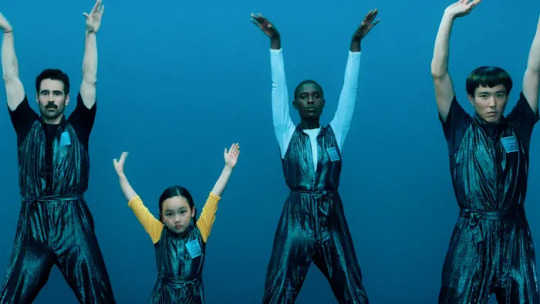
Best Editing of 2022
WINNER: After Yang (dir. Kogonada)
RUNNER UPS
Bret Morgen for Moonage Daydream
Blair McClendon for Aftersun
Paul Rogers for Everything Everywhere All At Once
Agnieszka Glińska for EO

Best Cinematography of 2022
WINNER (TIE): Athena (by Matias Boucard) and EO (by Michal Dymek)
RUNNERS-UP:
Joyland (by Joe Saade)
Moneyboys (by Jean-Louis Uialard)
Close (By Frank van den Eeden)
Neptune Frost (by Anisia Uzeyman)
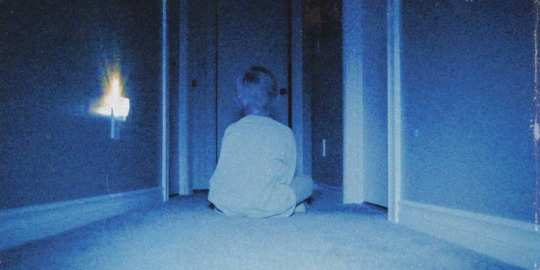
Best Sound of 2022
WINNER: Kyle Edward Ball for Skinamarink

Best Short Live Action Film
WINNER: Tremor by Rudolf Fitzgerald-Leonard
RUNNER UP: Starfuckers by Antonio Marziale

Best Short Documentary Film
WINNER: Will You Look At Me? by Huang Shuli
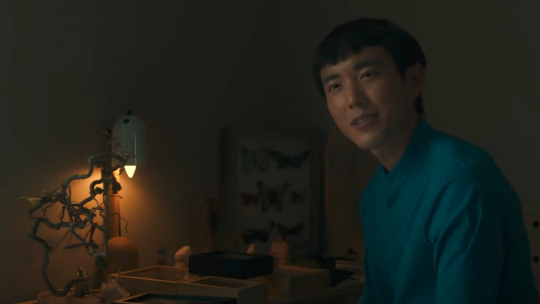
Best Actor in a Supporting Role
WINNER: Justin H. Min (in After Yang)
RUNNERS-UP:
Bai Yufan (in Moneyboys)
Sami Slimane (in Athena)
Gustav De Waele (in Close)
Pablo Schils in Tori & Lokita

Best Actress in a Supporting Role
WINNER: Alina Khan (in Joyland)
RUNNERS-UP:
Hong Chau (in The Whale)
Charlbi Dean Kriek (in Triangle of Sadness)
Dolly De Leon (in Triangle of Sadness)
Stephanie Hsu in Everything Everywhere All At Once
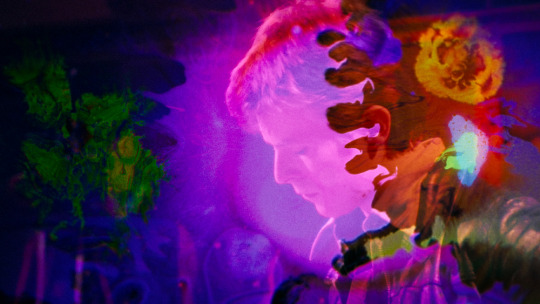
Best Documentary of The Year
WINNER: Moonage Daydream
RUNNERS-UP
All The Beauty and the Bloodshed
The Fire Within

Best Costume and Production Design
WINNER: Neptune Frost

Best Horror Film
WINNER: Terrifier 2
RUNNERS-UP
Skinamarink
Pearl
You Won’t Be Alone
The Outwaters
19 notes
·
View notes
Video
vimeo
Dell Seeing More from Onesal on Vimeo.
Seeing More
Dell XPS 13
Onesal collaborated with Elastic in the creation of a series of films for Dell based on exploratory CG simulations to promote the release of their new Dell XPS 13 high-end laptop.
Working closely with Director Paul Mitchell, we developed a campaign that illustrates human reactions to content focusing on the human iris, making use of different elements and materials such as hair, sand, and vegetation.
Onesal was in charge of doing the research and development and CG through production under the direction of Elastic.
Credits:
Client: Dell
Agency: Y&R
Chief Creative Officer:
Executive Creative Directors: Fern Cohen, Margot Owett
Creative Directors: Elliott Graham
Producer: Larissa Ananko
Executive Producer: Bobby Jacques
Sr. Business Affairs Manager: Maggie Diaz
____________________________________________________________________________
Onesal Team:
Design: Damian Sendin, Nahuel Salcedo, Mariano Abel, Fede Kanno
Animation: Nahuel Salcedo, Damian Sendin, Mariano Abel, Fernando Cimino
Additional Animation: Juan Manuel Isola
Simulation Artists: David Albrecht Kvien, Taishi Yagyu, Damian Sendin, Nahuel Salcedo
Assitant Simulation Artits: Yu Fujishiro, Alexia Oylataguerre
2D VFX artist: Matias Mastrogiano
Laptop Modeling: Juan Martin Miyagi
Production: Ailin Brunner, Lucia Gutkin
Production Assistant: Ceci Delu
____________________________________________________________________________
Elastic Team:
Director: Paul Mitchell
Art Director: James Levy
Designer: Mert Kizilay
Editors: Justine Gerenstein, Kenny Breit, Doron Dor, Fred Fouquet
CG Supervisor: Kirk Shintani
2D VFX Artists: Jason Forster, Maciek Sokalski, Kevin Kim, Peter Sidoriak, Stefan Galliot
Steven Wolff, Matt Sousa
Online Editors: John Valle, Chris Riley, Sam Kolber
Producer: Jacklyn Ramirez
Pitch Producer: Meredith Cherniack
Executive Producer: Luke Colson
Head of Production: Kate Berry
Managing Director: Jennifer Sofio Hall
____________________________________________________________________________
COLOR
Colorist: Paul Yacono
Color Assistant: Gabe Sanchez
Color Producer: Jenny Bright
Executive Producer: Thatcher Peterson
________________________________________________________________________
SOUND
Music Company: MachineRoom SoundLounge
Final Mix: Alicia Rodgers
0 notes
Text
Prediction Phoenix Suns - Philadelphia 76ers 03/28/22
Prediction Phoenix Suns – Philadelphia 76ers 03/28/22
Can the Sixers, with Harden and Embiid, put the Suns, with Paul and Booker in trouble?
By Matias Dumas
Published on 03/27/2022 at 2:31 p.m.updated 03/27/2022 at 4:31 p.m.
Content designed and provided by SportSight
Two teams with big aspirations for the Playoffs will face each other in Arizona. Sure enough, the Suns will host the Philadelphia 76ers in Phoenix. Considering this may be Chris…

View On WordPress
0 notes
Text



0 notes
Text
If you’re reading this,
Please know that nothing is ever your fault; it’s actually your family’s own fault that they hurt you because they’re sick in the head and just wanted a scapegoat. No, they’ve never punished you because you did something wrong; they actually only punished you because you existed. You were never a bad kid; you were just an abused kid, an easy target for them to take their stress, anger, frustration and hatred out on you. It didn’t even matter what you did; you could be bad and get punished; you could be good and still get punished. They made sure that there was no other way out for you. You couldn’t even make them stop because they didn’t want to; after all, they knew damn well that you were completely powerless and just kept making sure that it always stayed that way.
Also, you didn’t deserve anything they have done to you; you deseved so much better than that! You deserved better parents than those you were unfairly given; you deserved a better brother than that; you deserved a better family than that; you deserved a better childhood than that; you deserved a better life than that and YOU. DESERVED. BETTER.
Also, you were never immature (nor acting like a baby) for watching those “yucky” cartoons that they knew damn well other kids your age were watching at those times; you were just a kid; you were just doing normal kid things and they would just rather turn you into a miniature adult that they always wanted you to be...and I know why they did that. It’s because they always wanted you to wear very “fashionable” clothes (oh, excuse me, designer clothes that are extremely fancy, extremely expensive, extremely tight and extremely uncomfortable), to strive to look your best for the likes of men, to never say “no” to anything they said, to watch cooking shows (or news or even movies that are too mature for you) without complaining, to only listen to music that they approved of (i.e. Joe Dassin, Edith Piaf, Patricia Kaas, Charles Aznavour, Yaki-Da, Teach-In, Matia Bazaar, Mirielle Mathieu, Yves Montand, Space, Salvadore Adamo, Bimbo Jet, Paul Mauriat, Amanda Lear, Toto Cutugno, Mina, Ricchi e Poveri, Gepy & Gepy, Adriano Celentano, Pupo, Blue System, Modern Talking, Secret Service, Arabesque, Alla Pugacheva, Al Bano & Romina Power, Bad Boys Blue, DJ Bobo, Vaya Con Dios, Falco, Dalida, Demis Roussos, Eruption/Precious Wilson, Gilla, Dchingis Khan, Alain Delon, Victor Lazlo, Mylène Farmer, Leonard Cohen, F.R. David, Joy and more), to never get angry and to just be obedient; therefore, they just wanted you to be a perfect woman and to only exist for men. Disgusting! You don’t exist for men; you exist to be happy instead!
Again, please know that it was never your fault and that you didn’t make them abuse you; if anything, they chose to abuse you. They chose to beat you up and hurt you. If there was a time machine, I would gladly go back in time and do my best to save you. You deserved better.
-My letter to all of my younger selves of all ages
#child abuse#childhood abuse#sibling abuse#abusive mother#abusive father#abusive brother#abusive parents#abusive family#misogyny tw#enbyphobia tw#exorsexism tw#childhood trauma#abusive childhood#trauma#ptsd#cptsd
35 notes
·
View notes
Text
off the rack #1292
Monday, December 16, 2019
I sure got a heavy cardio workout yesterday scraping off the ice from both vehicles after the rain on Saturday froze under a layer of snow overnight into Sunday morning. That kind of temperature change will give you whiplash. The frozen blowing snow covered half of our birdfeeders too so I had to clear those off for our feathered friends. It's despairing when the temperature drops during the day instead of getting warmer. Stupid Arctic Air Mass.
The Red Mother #1 - Jeremy Haun (writer) Danny Luckert (art) Ed Dukeshire (letters). The first page with the disintegrating skull will give you an idea of what this beautifully drawn new story is about. Daisy and her boyfriend Luke are walking home from dinner when they are attacked in a scary black space behind an iron gate. Luke is hauled into the blackness and Daisy has her right eye plucked out but survives. By the end of this issue she's seeing scary things through a haze of red. I loved the art in this and look forward to meeting Mother.
Harley Quinn & Poison Ivy #4 - Jody Houser (writer) Adriana Melo (pencils) Mark Morales & Wade von Grawbadger (inks) Hi-Fi (colours) Gabriela Downie (letters). The Floronic Man attacks the girls again. This time in a roadside dinosaur theme park run by a crazy old lady. Poison Ivy figures out how the bad guy is tracking them and Harley fixes that problem with a machete. This is one crazy story.
Punisher Soviet #2 - Garth Ennis (writer) Jacen Burrows (pencils) Guillermo Ortego (inks) Nolan Woodard (colours) Rob Steen (letters). Frank has reluctantly taken on a teammate in his fight with a Russian mobster. This issue starts that guy's origin story.
Something is Killing the Children #4 - James Tynion IV (writer) Werther Dell'Edera (art) Miquel Muerto (colours) AndWorld Design (letters). Erica goes shopping for monster killing tools and into the woods we go. Time to meet the monster.
X-Force #3 - Benjamin Percy (writer) Joshua Cassara (art) Guru-eFX (colours) VC's Joe Caramagna (letters). The enemy is revealed and they are Xeno. Kind of reminds me of the Court of Owls from Batman. Wolverine and Kid Omega rescue Domino from their clutches while a new Charles Xavier is hatched with a rebuilt Cerebro to lead the war. I liked how Magneto made a sword for Charles from the broken Cerebro helmet.
The Dollhouse Family #2 - M. R. Carey (writer) Peter Gross (layouts) Vince Locke (finishes) Cris Peter (colours) Todd Klein (letters). Maybe I'm wrong but I suspect that the M. in the writer credit stands for Mike. I loved Mike Carey's Vertigo books and this has a very familiar feel. I like how the house is a character too.
The Immortal Hulk #28 - Al Ewing (writer) Tom Reilly & Matias Bergara (art) Chris O'Halloran (colours) VC's Cory Petit (letters). The villain gets the spotlight this issue as Roxxon C.E.O. Dario Agger tries to find a way to fight the Hulk. He goes to find an ally on Monster Isle and I laughed when I saw who it was.
Valkyrie #6 - Al Ewing & Jason Aaron (writers) Pere Perez (art) Jesus Aburtov (colours) VC's Joe Sabino (letters). What a great read. This is an example of how two good writers can produce a highly enjoyable issue of a comic book. Add to that very nice art and you've got a "pick of the week". Part one of "Strange Aeons" starts a new story where Val needs to put together a team to save Death. Doctor Strange is her first recruit and Night Nurse, Cardiac, Doctor Faiza Hussain AKA Excalibur and Manikin make the journey to the valley of the shadow of death. Talk about D-list, but I trust that Al and Jason will make good use of these heroes.
Detective Comics #1017 - Tom Taylor (writer) Fernando Blanco (art) John Kalisz (colours) Travis Lanham (letters). This is a great one issue story if you want to see why this comic book is on my "must read" list. Batman solves two crimes and I was happy to see Damian helping out. If Tom Taylor did a Robin book, I'd read that too.
Fantastic Four #17 - Dan Slott (writer) Luciano Vecchio, Carlos Magno, Bob Quinn & Sean Izaakse (art) Erick Arciniega (colours) VC's Travis Lanham (letters). I was wondering why this story was called "Point of Origin" and this issue explain why. We all know that the Fantastic Four were bombarded with cosmic rays when they took their maiden flight and that's what gave them their super powers. Little did we know it wasn't an accident. It's a subtle change and doesn't make a lot of difference in the grand scheme of things but it is kind of neat.
Miles Morales: Spider-Man #13 - Saladin Ahmed (writer) Javier Garron (art pages 1-2, 16-20) Kevin Libranda (art pages 3-8) & Alitha Martinez (art pages 9-13) David Curiel & Protobunker (colours) VC's Cory Petit (letters). I usually get annoyed when an issue is drawn by a bunch of different artists but Javier, Kevin and Alitha all did a splendid job and the story flowed seamlessly. The awesome colouring job helped too. Say hello to Billie Mariana Morales. Miles is now a big brother.
Superman #18 - Brian Michael Bendis (writer) Ivan Reis (pencils) Joe Prado (inks) Alex Sinclair (colours) Dave Sharpe (letters). As big a Brian Bendis fan that I am, I stopped reading this title because I wasn't interested in what was happening in the book. Now I'm interested again. Superman drops a bomb that's going to explode into all kinds of repercussions. I liked how Wonder Woman, Batman and Lex Luthor reacted to the news even though they don't utter a word. That's great art right there. The cover will give you a hint to what Superman's announcement is.
Fallen Angels #3 - Bryan Hill (writer) Szymon Kudranski (art) Frank D'Armata (colours) VC's Joe Sabino (letters). Cable, Psylocke and X-23's mission to save some children continues and one of the heroes is captured by the enemy. I hope their next story happens in the daytime because these issues have been very dark.
Dark Knight Returns: The Golden Child#1 - Frank Miller (writer) Rafael Grampa (art) Jordie Bellaire (colours) John Workman & Deron Bennett (letters). No returning Dark Knight since this story features Lara, Jonathan and Carrie, the kids of the Big Two. They battle old man Joker and old man Darkseid. I loved the art. The writing was annoyingly repetitive. That seems to be Franks writing style now using lots of verbs and choppy little captions. I don't like it. The thing about comic books is that the art and writing go hand in hand and I just couldn't stop reading the words part way and just look at the pretty pictures. Seeing Greta Thunberg on the last page just made me love Rafael even more.
Friendly Neighborhood Spider-Man #14 - Tom Taylor (writer) Marguerite Sauvage (art flashback) Ken Lashley (art) Marguerite Sauvage & Rachelle Rosenberg (colours) VC's Travis Lanham (letters). Crappydoodles! This is the last issue. I am sad. I enjoyed the entire 14-issue run. It was Juann Cabal's art that got me hooked but Tom's writing kept me reading. His stories were very Mister Rogers and I liked them a lot. He showed Peter committed to his sense of responsibility and ended this issue nicely. I'm going to miss this title.
The Batman's Grave #3 - Warren Ellis (writer) Bryan Hitch (pencils) Kevin Nowlan (inks) Alex Sinclair (colours) Richard Starkings (letters). Batman is working on a case of murder disguised as a suicide. I like how this issue starts and ends with him working the case with Alfred in the Batcave that bookends 10 pages of wordless solo crime scene investigation and a fight with an intruder for a crucial clue.
2099: Doom #1 - Chip Zdarsky (writer) Marco Castiello (art) Chris Sotomayor (colours) VC's Clayton Cowles (letters). This one-shot doesn't add much to the overall story but I like Chip's writing so I read it. Victor winds up in 2099 fighting his future self. The last page doesn't make a lot of sense so skipping this comic won't hurt much.
2099: Spider-Man #1 - Nick Spencer (writer) Ze Carlos (art) Brian Reber & Andrew Crossley (colours) VC's Cory Petit (letters). I was as confused as the Miguel in this story when I got to the end. We get a sense of what's happening in 2099 that's bad for everyone but there's no connection to the main story as far as I can make out. These 2099 one-shots have been a waste of time, which doesn't bode well for Marvel's next big event. I'll read 2099 Omega to see if there's a point to this story and I'll read The Amazing Spider-Man #36 that ties into this event because that book is on my "must read" list, but Nick Spencer is skating on thin ice with me.
Annihilation - Scourge: Beta Ray Bill #1 - Michael Moreci (writer) Alberto Alburquerque (art) Jay David Ramos (colours) VC's Joe Sabino (letters). This was a good single issue story. Beta Ray Bill goes up against the Sentry and saves our universe from the scourge of the Cancerverse. I liked that he's teamed up with Lockjaw.
Annihilation - Scourge: Silver Surfer #1 - Dan Abnett (writer) Paul Davidson (art) Matt Milla (colours) VC's Clayton Cowles (letters). I was asked recently if the Silver Surfer was good or evil after the Silver Surfer Black story and I didn't know the answer until now. This tie-in one-shot takes place right after Silver Surfer Black as Norrin Radd breaches the barrier between the positive universe and the Negative Zone to investigate what's causing the mass exodus from Annihilus's realm. Here he finds the means of defeating the Void controlled Sentry and thereby save two universes. He also discovers the ability to merge with another being sort of like DC's Deadman.
2 notes
·
View notes
Photo

For the week of 18 March 2019
Quick Bits:
Aquaman #46 is the penultimate chapter of “Unspoken Water”, as “Andy” and Caille confront Namma. I love the world-building that Kelly Sue DeConnick is doing here, enriching DC’s godly pantheons greatly, and I swear that Robson Rocha, Daniel Henriques, and Sunny Gho are somehow getting better with each subsequent issue. Epic storytelling.
| Published by DC Comics
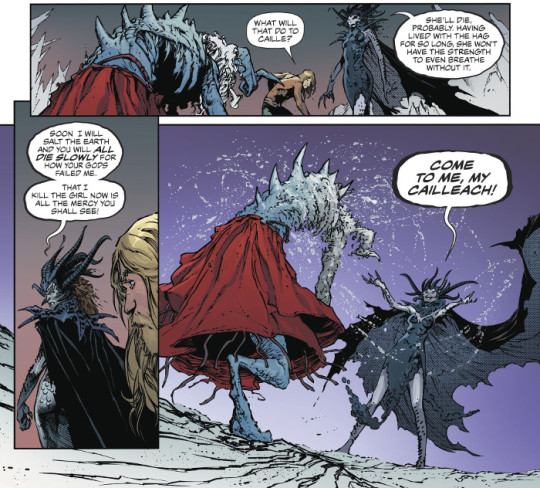
Avengers #17 concludes the war of the vampires from Jason Aaron, David Marquez, Erick Arciniega, and Cory Petit. It’s as gloriously over-the-top as the entire story-arc and it sets up a new status quo for the Winter Guard as well as a few other surprises. The art from Marquez and Arciniega is glorious.
| Published by Marvel

Avengers: No Road Home #6 gives an extra-sized issue for Conan and Scarlet Witch’s adventure from Jim Zub, Al Ewing, Mark Waid, Sean Izaakse, Jay David Ramos, Marcio Menyz, and Cory Petit. It works well as a Conan story with monsters and magic, while still giving a bit of insight as to what horrors are still occurring on the traditional 616-side.
| Published by Marvel
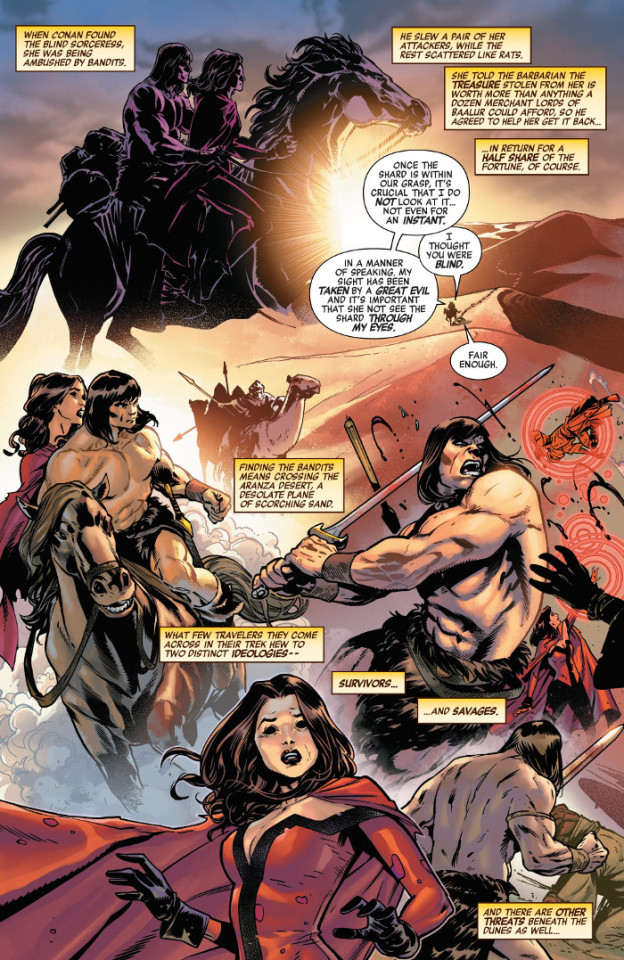
Batman #67 is almost dialogue-free, leaving the bulk of the storytelling up to the art and sound effects from Lee Weeks, Jorge Fornés, Lovern Kindzierski, and Clayton Cowles. It’s damn good.
| Published by DC Comics

Black Badge #8 gives some rare insight into who the kids really are as Matt Kindt, Tyler Jenkins, Hilary Jenkins, and Jim Campbell dive into observational reports from the White Badges. I absolutely love the layers to the characters, as the black ops, highly secretive world that they operate in reveals even more secrets.
| Published by BOOM! Studios

BPRD: The Devil You Know #14 is the penultimate chapter in the Hellboy saga that began 25 years ago. Like every issue of “Ragna Rok”, there are some goodbyes here, checking in on numerous characters throughout the story’s history, and the continued confrontation between Hellboy, Abe, & Liz and Rasputin. This one hurts, a lot. Beautifully depicted by Laurence Campbell and Dave Stewart.
| Published by Dark Horse

Captain Marvel #3 reveals Som’s secrets while Carol tries to build an army out of the survivors. This one’s definitely a bit of a breather as the team works out a plan to take on Nuclear Man. There’s some nice character building with Carol, Hazmat, She-Hulk, and Echo. Carmen Carnero, with colours from Tamra Bonvillain, also continues to impress.
| Published by Marvel
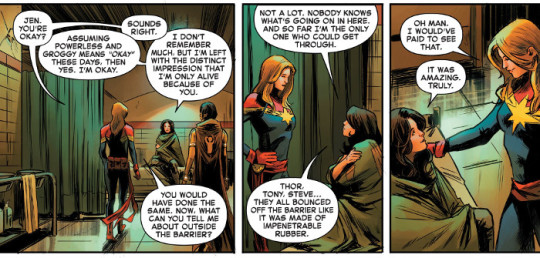
Criminal #3 concludes the two-part “Bad Weekend” arc. I’m really quite liking how Ed Brubaker, Sean Phillips, and Jacob Phillips are approaching this series, telling a variety of tale throughout time, building up existing and new characters, and really giving depth to the world.
| Published by Image

Dark Red #1 is a great debut from Tim Seeley, Corin Howell, Mark Englert, and Marshall Dillon exploring the concept of the American vampire, like True Blood, American Vampire, or Redneck. It goes a little bit simpler diving into the ordinary, rural, service sector life of Chip the vampire, which makes for the twist in the plot more intriguing.
| Published by AfterShock

Electric Warriors #5 pulls out some more surprises in this penultimate chapter. Steve Orlando, Travel Foreman, Javi Fernandez, Richard Friend, Hi-Fi, and Travis Lanham spark the rebellion here setting up a cliffhanger for a very interesting conclusion.
| Published by DC Comics

Farmhand #6 returns from its break, weirder than ever. Amidst the EPA crawling down Jed’s labs throat trying to figure out what happened with the weird side effects and bizarre spread, Jedediah, Zeke, Riley, and Mikhail go fishing. Odd, that. Wonderfully bizarre story and art as always from Rob Guillory, Taylor Wells, and Kody Chamberlain.
| Published by Image

Guardians of the Galaxy #3 advances “The Final Gauntlet” from Donny Cates, Geoff Shaw, Marte Gracia, and Cory Petit as Starfox’s Dark Guardians continue to try to beat Gamora’s location out of people and the real Guardians try to convince Star-Lord to help protect her. Very nice bits of humour, phenomenal artwork, some interesting developments regarding Wraith and Knull, and I’m really getting the impression that the “new Thanos” is the scarred and broken Starfox.
| Published by Marvel

Immortal Hulk #15 is more brilliance from Al Ewing, Joe Bennett, Ruy José, Paul Mounts, and Cory Petit. This arc definitely seems to be focused on Hulk’s old friends and family, with this issue featuring Doc Samson, and it’s a wonderful exploration of how Samson is alive again and an analysis on who this Hulk happens to be.
| Published by Marvel

Incursion #2 feels even more epic than the first issue as Gilad turns to Doctor Mirage for assistance, then sets out on a quest through the Deadside. Andy Diggle, Alex Paknadel, Doug Braithwaite, Diego Rodriguez, and Marshall Dillon are crafting what feels like one of the next foundation stones for the future of the Valiant universe. With some of the best art I’ve seen from Braithwaite and Rodriguez.
| Published by Valiant

Infinity 8 #10 begins the fourth cycle, “Symbolic Guerrilla”, adding Kris and Martin Trystram to the creative mix, to introduce us to undercover agent Patty Stardust, stage manager to the Symbolic Guerrillas band, as she gets tapped to try to figure out what’s causing the ship’s destruction and try to stop it. Absolutely love the art from Trystram.
| Published by Lion Forge / Magnetic Collection

Invisible Kingdom #1 is gorgeous. I’m a huge fan of Christian Ward’s artwork and this is incredible. Beautiful use of colour, fascinating character and architecture designs, interesting layouts, delivering a sense of the alien and the familiar at the same time. Between Ward’s art and G. Willow Wilson’s concepts and character building, this feels like they’ve put a lot of thought into world building and it pays off in what feels like a living, breathing society and culture in this first issue. Also a nice mix of “futuristic” and normal lettering from Sal Cipriano that aids nicely in setting the tone and atmosphere for the story. This is an auspicious debut and looks like it should be another hit for Berger Books.
| Published by Dark Horse / Berger Books

Justice League #20 continues “The Sixth Dimension” from Scott Snyder, Jorge Jimenez, Alejandro Sánchez, and Tom Napolitano. The artwork from Jimenez and Sánchez is worth the price of admission alone, this is an incredibly beautiful looking book.
| Published by DC Comics

Lazarus: Risen #1 is the very welcome return of the series from Greg Rucka, Michael Lark, Tyler Boss, Santi Arcas, and Simon Bowland in its new double-sized quarterly format, which also includes a short story from Lilah Sturges, some RPG content from Crystal Frasier, and other assorted backmatter. It’s good. Damn good. Easing us back into the conflict of the world as Johanna Carlyle starts taking care of the family’s problems as more conflict and complications begin to arise. Incredible artwork from Lark, Boss, and Arcas.
| Published by Image

Meet the Skrulls #2 continues to be highly entertaining as the family enacts some of their plans and Carl certainly isn’t going to win any father of the year awards. Niko Henrichon’s artwork is a huge plus for the story, nicely balancing the normal world, the alien nature of the Skrulls, and some neat monster designs to boot.
| Published by Marvel

Middlewest #5 gives us a bit of a look back at how much of an abusive asshole Abel’s father is, while in the present Abel makes an arrangement with the carnival folks. Jorge Corona and Jean-Francois Beaulieu continue to make this one of the most visually interesting series running.
| Published by Image

Naomi #3 presents a number of revelations about some of the characters, including Naomi’s mom acting like a savage mama bear, but not exactly the revelations you’d expect. Brian Michael Bendis and David F. Walker are still taking it a bit slow as to what exactly is going on with Naomi herself, instead building up the characters around her (part of me wonders if she’s actually a Monitor). Also, Jamal Campbell’s artwork remains stunning, truly beautiful work.
| Published by DC Comics / Wonder Comics

Outpost Zero #8 takes us out onto the ice to show what happened when the drill team uncovered the dome, then spends the rest of the issue dealing with the ramifications of that, making the residents of Outpost Zero even more reluctant to go outside to do anything to protect themselves, and the kids still don’t know what to make of what they say. This is kind of a taking stock issue, with the characters trying to figure out next steps again.
| Published by Image / Skybound
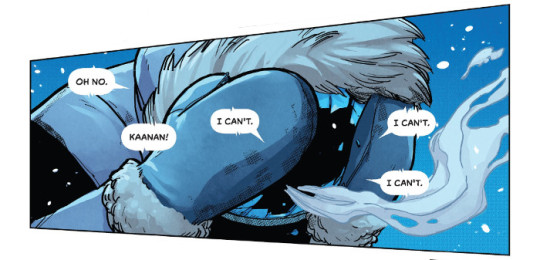
Pearl #7 returns with a new arc from Brian Michael Bendis, Michael Gaydos, and Dave Sharpe, with Pearl “on the run” from Mr. Miike, the Endo Twins, and a new player in the FBI’s Yuko Masako. This is developing more of Bendis’ dialogue tics as time goes by, but they’re largely forgiven for just how incredible Gaydos’ artwork is.
| Published by DC Comics / Jinxworld
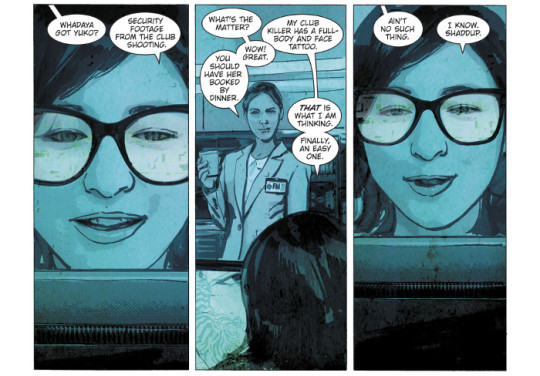
Sparrowhawk #5 concludes what has been an excellent fantasy adventure from Delilah S. Dawson, Matias Basla, Rebecca Nalty, and Jim Campbell with the confrontation between a fully-changed Artemisia and the faerie queen. It’s great, with some interesting ramifications in all of what Artemisia has lost in her quest to return home for revenge. Great artwork from Basla and Nalty.
| Published by BOOM! Studios

Spider-Man: Life Story #1 is off to an interesting start from Chip Zdarsky, Mark Bagley, John Dell, Frank D’Armata, and Travis Lanham. It’s an introspective look at Peter Parker’s life, with some key moments, starting off in the ‘60s deeply tied to then-current events. Some of the best art from Bagley I’ve seen in a while, really nice stuff.
| Published by Marvel
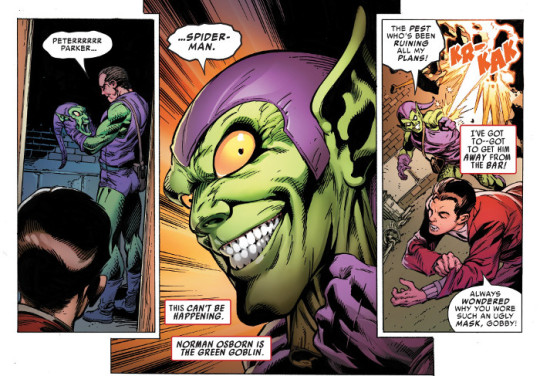
Stronghold #2 continues the impressive world-building from Phil Hester, Ryan Kelly, Dee Cunniffe, and Simon Bowland. We’re introduced this issue to the opposite side in The Adversary and his minions, while the “good” of the Stronghold is put into question and Michael continues to wrestle with who and what he is. Great character work from Hester accompanied by some terrific art from Kelly and Cunniffe.
| Published by AfterShock

Teen Titans #28 is part one of the “Terminus Agenda” crossover with Deathstroke and it kicks off with a bang. Damian’s been travelling down a potentially dark and dangerous road for awhile and it looks like it may be coming to a head with this arc. Amazing action artwork from Bernard Chang and Marcelo Maiolo as the Teen Titans and Deathstroke clash.
| Published by DC Comics

Teenage Mutant Ninja Turtles #92 delves into the negotiations of transfer of power of the Foot Clan to Karai in earnest, delivering some interesting complications to the story that look like they’re going to have significant ramifications. Michael Dialynas, with colours from Ronda Pattison, consistently provides some of the best depictions of the Turtles and the Mutanimals.
| Published by IDW
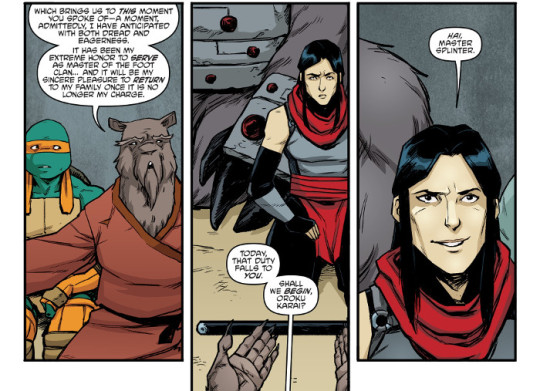
Thor #11 serves as a counterpoint to last issue’s conflict with Odin, as Thor is aided by his step-mother, Freyja, on the even of The War of the Realms. Beautiful guest art from Lee Garbett and Antonia Fabela.
| Published by Marvel

Venom #12 is another big issue. With art from Joshua Cassara and Rain Beredo, we get more insight into Eddie’s son and a startling development, even after last issue, regarding the symbiote. Donny Cates and the entire creative team are really going full-bore in developing compelling additions to Venom’s mythos.
| Published by Marvel

The Warning #5 feels like one of the first major payoffs for sticking with the story. Edward Laroche has been giving this a real slowburn, making it decidedly feel like chapters and snippets from a work that should probably be read at once. They've been good, but not always entirely satisfying as monthly comics. The set-up last issue and the incendiary contact this issue, though, have really lit a fire to the action.
| Published by Image

West Coast Avengers #9 is kind of bittersweet. It’s another fun issue, full of humour, great character development, and wonderful artwork--from Kelly Thompson, Gang Hyuk Lim, Tríona Farrell, and Joe Caramagna--but it’s the second-to-last issue. I feel like the industry needs more of these types of upbeat superhero series, not less. Especially for Jeff the Land Shark puppy.
| Published Marvel
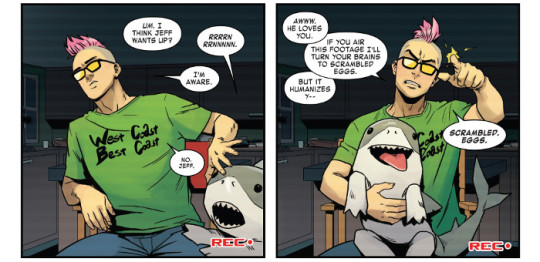
X-O Manowar #25 is largely all-battle between the bounty hunters and Aric & Schon from Matt Kindt, Tomás Giorello, Diego Rodriguez, and Dave Sharpe. Kindt gets in some nice character moments between Aric and Schon, but you're going to be wanting to pick this up for more gorgeous artwork from Giorello and Rodriguez.
| Published by Valiant

Other Highlights: American Carnage #5, Archie #703, Aristophania - Volume 1: The Kingdom of Azur, Bitter Root #5, Bloodborne #10, Delver #2, Dungeons & Dragons: A Darkened Wish #1, Edgar Allan Poe’s Snifter of Terror #6, Evolution #14, Firefly: Bad Company #1, Friendly Neighborhood Spider-Man #4, Grumble #5, Haphaven, High Level #2, James Bond 007 #5, Jessica Jones: Purple Daughter #3, JesusFreak, Kaijumax Season 4 #5, Lucifer #6, Lumberjanes #60, Marvel Action: Avengers #3, Miles Morales: Spider-Man #4, Monstress #21, Rainbow Brite #5, Savage Sword of Conan #3, Solo: A Star Wars Story #6, Spider-Man: City at War #1, Star Wars #63, Superb #18, Wizard Beach #4
Recommended Collections: Batman - Volume 9: The Tyrant Wing, Beasts of Burden: Wise Dogs & Eldritch Men, Belzebubs, BPRD: Hell on Earth - Volume 5, Crowded - Volume 1, Encounter - Volume 2, Family Man, Harrow County Library Edition - Volume 2, Nancy Drew: Palace of Wonder, Polar - Volume 4: Kaiser Falls, Seven to Eternity - Volume 3

d. emerson eddy has been to Flavortown. It was an experience.
3 notes
·
View notes
Photo

LAST COPIES! The Most Beautiful Swiss Books - The Future Issue / Available at www.draw-down.com / This annual publication showcases the results of the competition “The Most Beautiful Swiss Books,” coordinated by the Swiss Ministry of Culture and aimed at promoting #Swissbookdesign. The Future Issue is the third catalogue in the Back To The FutureTrilogy, which reflects on the past, present and future of book design. With contributions by Susanna Bliggenstorfer, Lionel Bovier, Mercedes Bunz, Hans Burkhardt, Hans ten Doornkaat, Paul Elliman, Experimental Jetset, Matias Faldbakken, Hans-Peter Feldmann, Jesko Fezer, Dominique Gonzalez-Foerster, Will Holder, Richard Hollis, Christophe Keller, Emily King, Aude Lehmann, Jürg Lehni, Beat Mazenauer, NORM, Peter Piller, Martin Schmitt-Lewen, Guy Schraenen, Gerhard Steidl, Erik Steinbrecher, Jim Stoddart, Daniel van der Velden, Daniel B. Visel, Lawrence Weiner, and Gabriel Zaid. Designed by #LaurenzBrunner #Graphicdesign #typography (at Switzerland) https://www.instagram.com/p/BsndFBHA221/?utm_source=ig_tumblr_share&igshid=oe1xmosdr2ts
5 notes
·
View notes
Text
San Jose Earthquakes 2022 preview: One last hurrah?

Jeffrey Swinger-USA TODAY Sports
Matias Almeyda enters Year 4 with the Earthquakes still with plenty to pove.
Look, I know what you are thinking, this San Jose Earthquakes team is the “same old Quakes.” They are a low-spending, fringe-MLS Playoffs-caliber team. This year is different, they have changed, they have given Matias Almeyda three Designated Players to use. This is the first time in his stint in San Jose that Almeyda has all three DP slots filled. It almost seems a little too late, as Almeyda only has one year left on his contract. Even given the circumstances, this is still a Matias Almeyda team. With Almeyda leading the ship, ANYTHING can happen.
San Jose Earthquakes (2021 record,10-11-13)
Head coach: Matias Almeyda
Key additions: Jan Gregus, Will Richmond, Ousseni Bouda, Niko Tsakiris, Francisco Calvo, Jamiro Monteiro
Key losses: Luciano Abecasis, Jacob Akanyirige, Eric Calvillo, Carlos Fierro, Andy Rios, Thomas Williamson, Daniel Vega, Chris Wondolowski, Oswaldo Alanis
Projected Best XI

(5-3-2): Marcinkowski; M.Lopez, Calvo, Yueill, Nathan, Espinoza, Monteiro, Gregus, Chofis, Cowell, Ebobisse
Best offseason move
Jamiro Monteiro is the first true playmaker the Earthquakes have had under Almeyda. A move that no one saw coming due to the Earthquakes never having all three DPs slots filled under Almeyda. During his time with Philadelphia, the Union finished top three in the Eastern Conference each season and won the Supporters’ Shield in 2020 with a league-best 14-4-5 record. This move provides the Earthquakes cover if Chofis Lopez does not get purchased after his six-month loan is over.
Best reason to pay attention
The players on the Earthquakes all have something to prove this year. For example, Jeremy Ebobisse has to prove that he was worth his high transfer fee. Cade Cowell has to prove himself to the European suitors that come to scout him at the games. Chofis Lopez has to prove to the San Jose Earthquakes front office that he’s worth his $3 million price tag that Chivas has on him. Cristian Espinoza has to prove that he’s one of the most underrated players in the league. As you can see, almost every single player on this roster has something to prove. Let’s not forget who has to prove the most, that is Matias Almeyda. Most MLS fans and pundits both would label as the Almeyda “Man Mark” system as a flop in MLS. Given all the excuses to why it hasn’t worked these past three years, now is the time to make everyone eat their words. Matias Almeyda needs to prove to the world of soccer that he can still coach a team and have them reach the highest achievements.
The one glaring weakness
The glaring weakness the Earthquakes still need to fix, since Luciano Abecasis left to play for Banfield in Argentina, is at the right back position. If they go with 4 in the back, Espinoza can not play the RB position. They resigned Paul Marie, but he’s more to be a back-up for either side. Most likely the back-up for when Marcos Lopez goes to play for Peru. To try to fix this problem, Leitch drafted a right back in the third round of the MLS Super Draft. Hopefully this is insurance for Tommy Thompson getting surgery on his shoulder during the off season. This club still needs a quality right back. There are plenty in MLS that teams that would be willing to part ways with their RB. Ever since the Quakes struck out on Miguel Layun this spot has needed to be filled. There is a possibility they end up using Judson as a RB this season if they need to. Tommy Thompson could be a serviceable RB as well, but with the likes of Douglas Costa, Lorenzo Insigne and Facundo Torres, we are going to need a class RB.
One fact you can use to impress your friends
Shea Salinas is the fourth longest-serving MLS player to one club. He sits in fourth behind Diego Chara, Russell Teibert and Graham Zusi.
The Marvel Cinematic Universe character who most personifies this team
Ant-Man because we punch above our own weight, while the “Thanos” level teams overlook or completely forget about us. We get bigger versus the bigger spending clubs, and we give them a run for their money.
0 notes
Text
New Post has been published on Website Design Naples Florida Webmaster
New Post has been published on https://vinbo.com/wordpress-5-4-adderley/
WordPress 5.4 “Adderley”

Here it is! Named “Adderley” in honor of Nat Adderley, the latest and greatest version of WordPress is available for download or update in your dashboard.

Say hello to more and better.
More ways to make your pages come alive. With easier ways to get it all done and looking better than ever—and boosts in speed you can feel.
Welcome to WordPress 5.4
Every major release adds more to the block editor.
More ways to make posts and pages come alive with your best images. More ways to bring your visitors in, and keep them engaged, with the richness of embedded media from the web’s top services.
More ways to make your vision real, and put blocks in the perfect place—even if a particular kind of block is new to you. More efficient processes.
And more speed everywhere, so as you build sections or galleries, or just type in a line of prose, you can feel how much faster your work flows.

Two new blocks. And better blocks overall.
Two brand-new blocks: Social Icons and Buttons make adding interactive features fast and easy.
New ways with color: Gradients in the Buttons and Cover block, toolbar access to color options in Rich Text blocks, and for the first time, color options in the Group and Columns blocks.
Guess a whole lot less! Version 5.4 streamlines the whole process for placing and replacing multimedia in every block. Now it works the same way in almost every block!
And if you’ve ever thought your image in the Media+Text block should link to something else—perhaps a picture of a brochure should download that brochure as a document? Well, now it can.
Cleaner UI, clearer navigation—and easier tabbing!
Clearer block navigation with block breadcrumbs. And easier selection once you get there.
For when you need to navigate with the keyboard, better tabbing and focus. Plus, you can tab over to the sidebar of nearly any block.
Speed! 14% faster loading of the editor, 51% faster time-to-type!
Tips are gone. In their place, a Welcome Guide window you can bring up when you need it—and only when you need it—again and again.
Know at a glance whether you’re in a block’s Edit or Navigation mode. Or, if you have restricted vision, your screen reader will tell you which mode you’re in.
Of course, if you want to work with the very latest tools and features, install the Gutenberg plugin. You’ll get to be the first to use new and exciting features in the block editor before anyone else has seen them!

Your fundamental right: privacy
5.4 helps with a variety of privacy issues around the world. So when users and stakeholders ask about regulatory compliance, or how your team handles user data, the answers should be a lot easier to get right.
Take a look:
Now personal data exports include users session information and users location data from the community events widget. Plus, a table of contents!
See progress as you process export and erasure requests through the privacy tools.
Plus, little enhancements throughout give the privacy tools a little cleaner look. Your eyes will thank you!

Just for developers
Add custom fields to menu items—natively
Two new actions let you add custom fields to menu items—without a plugin and without writing custom walkers.
On the Menus admin screen, wp_nav_menu_item_custom_fields fires just before the move buttons of a nav menu item in the menu editor.
In the Customizer, wp_nav_menu_item_custom_fields_customize_template fires at the end of the menu-items form-fields template.
Check your code and see where these new actions can replace your custom code, and if you’re concerned about duplication, add a check for the WordPress version.
Blocks! Simpler styling, new APIs and embeds
Radically simpler block styling. Negative margins and default padding are gone! Now you can style blocks the way you need them. And, a refactor got rid of four redundant wrapper divs.
If you build plugins, now you can register collections of your blocks by namespace across categories—a great way to get more brand visibility.
Let users do more with two new APIs: block variations and gradients.
In embeds, now the block editor supports TikTok—and CollegeHumor is gone.
There’s lots more for developers to love in WordPress 5.4. To discover more and learn how to make these changes shine on your sites, themes, plugins and more, check the WordPress 5.4 Field Guide.
The Squad
This release was led by Matt Mullenweg, Francesca Marano, and David Baumwald. They were enthusiastically supported by a release squad:
Editor Tech: Jorge Filipe Costa (@jorgefelipecosta)
Editor Design: Mark Uraine (@mapk)
Core Tech: Sergey Biryukov (@sergeybiryukov)
Design: Tammie Lister (@karmatosed)
Docs Coordinator: JB Audras (@audrasjb)
Docs & Comms Wrangler: Mary Baum (@marybaum)
The squad was joined throughout the release cycle by 552 generous volunteer contributors who collectively worked on 361 tickets on Trac and 1226 pull requests on GitHub.
Put on a Nat Adderley playlist, click that update button (or download it directly), and check the profiles of the fine folks that helped:
0v3rth3d4wn, 123host, 1naveengiri, Aaron Jorbin, Abhijit Rakas, abrightclearweb, acosmin, Adam Silverstein, adamboro, Addie, adnan.limdi, Aezaz Shaikh, Aftab Ali Muni, Aki Björklund, Akib, Akira Tachibana, akshayar, Alain Schlesser, Albert Juhé Lluveras, Alex Concha, Alex Mills, AlexHolsgrove, alexischenal, alextran, alishankhan, allancole, Allen Snook, alpipego, Amir Seljubac, Amit Dudhat, Amol Vhankalas, Amr Gawish, Amy Kamala, Anantajit JG, Anders Norén, Andrés, Andrea Fercia, Andrea Tarantini, andreaitm, Andrei Draganescu, Andrew Dixon, Andrew Duthie, Andrew Nacin, Andrew Ozz, Andrew Serong, Andrew Wilder, Andrey Savchenko, Andy Fragen, Andy Meerwaldt, Andy Peatling, Angelika Reisiger, Ankit Panchal, Anthony Burchell, Anthony Ledesma, apedog, Apermo, apieschel, Aravind Ajith, archon810, arenddeboer, Ari Stathopoulos, Arslan Ahmed, ashokrd2013, Ataur R, Ate Up With Motor, autotutorial, Ayesh Karunaratne, BackuPs, bahia0019, Bappi, Bart Czyz, ben.greeley, benedictsinger, Benjamin Intal, bibliofille, bilgilabs, Birgir Erlendsson, Birgit Pauli-Haack, BMO, Boga86, Boone Gorges, Brad Markle, Brandon Kraft, Brent Swisher, Cameron Voell, Carolina Nymark, ceyhun0, Chetan Prajapati, Chetan Satasiya, Chintesh Prajapati, Chip Snyder, Chris Klosowski, Chris Trynkiewicz (Sukces Strony), Chris Van Patten, Christian Sabo, Christiana Mohr, clayisland, Copons, Corey McKrill, crdunst, Csaba (LittleBigThings), Dademaru, Damián Suárez, Daniel Bachhuber, Daniel James, Daniel Llewellyn, Daniel Richards, Daniele Scasciafratte, daniloercoli, Darren Ethier (nerrad), darrenlambert, Dave Mackey, Dave Smith, daveslaughter, DaveWP196, David Artiss, David Binovec, David Herrera, David Ryan, David Shanske, David Stone, Debabrata Karfa, dekervit, Delowar Hossain, Denis Yanchevskiy, Dhaval kasavala, dhurlburtusa, Dilip Bheda, dingo-d, Dion Hulse, dipeshkakadiya, djp424, dominic_ks, Dominik Schilling, Dotan Cohen, dphiffer, dragosh635, Drew Jaynes, eclev91, ecotechie, eden159, Edi Amin, edmundcwm, Eduardo Toledo, Ella van Durpe, Ellen Bauer, Emil E, Enrique Piqueras, Enrique Sánchez, equin0x80, erikkroes, Estela Rueda, Fabian, Fabian Kägy, Fahim Murshed, Faisal Alvi, Felipe Elia, Felipe Santos, Felix Arntz, Fernando Souza, fervillz, fgiannar, flaviozavan, Florian TIAR, Fotis Pastrakis, Frank Martin, Gal Baras, Garrett Hyder, Gary Jones, Gary Pendergast, Gaurang Dabhi, George Stephanis, geriux, Girish Panchal, Gleb Kemarsky, Glenn, Goto Hayato, grafruessel, Greg Rickaby, Grzegorz Ziółkowski, Grzegorz.Janoszka, Gustavo Bordoni, gwwar, hamedmoodi, hAmpzter, happiryu, Hareesh Pillai, Harry Milatz, Haz, helgatheviking, Henry Holtgeerts, Himani Lotia, Hubert Kubiak, i3anaan, Ian Belanger, Ian Dunn, ianatkins, ianmjones, IdeaBox Creations, Ihtisham Zahoor, intimez, Ipstenu (Mika Epstein), Isabel Brison, ispreview, Jake Spurlock, Jakub Binda, James Huff, James Koster, James Nylen, jameslnewell, Janki Moradiya, Jarret, Jasper van der Meer, jaydeep23290, jdy68, Jean-Baptiste Audras, Jean-David Daviet, Jeff Bowen, Jeff Ong, Jeff Paul, Jeffrey Carandang, jeichorn, Jenil Kanani, Jenny Wong, jepperask, Jer Clarke, Jeremy Felt, Jeremy Herve, Jeroen Rotty, Jerry Jones, Jessica Lyschik, Jip Moors, Joe Dolson, Joe Hoyle, Joe McGill, Joen Asmussen, John Blackbourn, John James Jacoby, John Watkins, Jon, Jon Quach, Jon Surrell, Jonathan Desrosiers, Jonathan Goldford, Jonny Harris, Jono Alderson, Joonas Vanhatapio, Joost de Valk, Jorge Bernal, Jorge Costa, Josepha Haden, JoshuaWold, Joy, jqz, jsnajdr, Juanfra Aldasoro, Julian Weiland, julian.kimmig, Juliette Reinders Folmer, Julio Potier, Junko Nukaga, jurgen, justdaiv, Justin Ahinon, K. Adam White, kaggdesign, KalpShit Akabari, Kantari Samy, Kaspars, Kelly Dwan, Kennith Nichol, Kevin Hagerty, Kharis Sulistiyono, Khushbu Modi, killerbishop, kinjaldalwadi, kitchin, Kite, Kjell Reigstad, kkarpieszuk, Knut Sparhell, KokkieH, Konstantin Obenland, Konstantinos Xenos, Krystyna, kubiq, kuflievskiy, Kukhyeon Heo, kyliesabra, Laken Hafner, leandroalonso, leogermani, lgrev01, linuxologos, lisota, Lorenzo Fracassi, luisherranz, luisrivera, lukaswaudentio, Lukasz Jasinski, Luke Cavanagh, Lydia Wodarek, M A Vinoth Kumar, maciejmackowiak, Mahesh Waghmare, Manzoor Wani, marcelo2605, Marcio Zebedeu, MarcoZ, Marcus Kazmierczak, Marek Dědič, Marius Jensen, Marius84, Mark Jaquith, Mark Marzeotti, Mark Uraine, Martin Stehle, Marty Helmick, Mary Baum, Mat Gargano, Mat Lipe, Mathieu Viet, Matias Ventura, Matt Keys, Matt van Andel, mattchowning, Matthew Kevins, mattnyeus, maxme, mayanksonawat, mbrailer, Mehidi Hassan, Mel Choyce-Dwan, mensmaximus, Michael Arestad, Michael Ecklund, Michael Panaga, Michelle Schulp, miette49, Miguel Fonseca, Miguel Torres, mihdan, Miina Sikk, Mikael Korpela, Mike Auteri, Mike Hansen, Mike Schinkel [WPLib Box project lead], Mike Schroder, mikejdent, Mikko Saari, Milan Patel, Milan Petrovic, mimi, mircoraffinetti, mjnewman, mlbrgl, Morgan Estes, Morteza Geransayeh, mppfeiffer, mryoga, Muhammad Usama Masood, mujuonly, Mukesh Panchal, Nadir Seghir, nagoke, Nahid Ferdous Mohit, Nate Finch, Nazmul Ahsan, nekomajin, NextScripts, Nick Daugherty, Nick Halsey, Nicklas Sundberg, Nicky Lim, nicolad, Nicolas Juen, nicole2292, Niels Lange, nikhilgupte, nilamacharya, noahtallen, noyle, nsubugak, oakesjosh, oldenburg, Omar Alshaker, Otto Kekäläinen, Ov3rfly, Paal Joachim Romdahl, page-carbajal, pagewidth, Paragon Initiative Enterprises, Pascal Birchler, Pascal Casier, Paul Bearne, Paul Biron, Paul Kevin, Paul Schreiber, pcarvalho, Pedro Mendonça, perrywagle, Peter Wilson, Philip Jackson, Pierre Gordon, Pierre Lannoy, pikamander2, Prashant Singh, Pratik Jain, Presskopp, Priyanka Behera, Raam Dev, Rachel Cherry, Rachel Peter, ragnarokatz, Rami Yushuvaev, raoulunger, razamalik, Remco Tolsma, rephotsirch, rheinardkorf, Riad Benguella, Ricard Torres, Rich Tabor, rimadoshi, Rinku Y, Rob Cutmore, rob006, Robert Anderson, Roi Conde, Roland Murg, Rostislav Wolný, Roy Tanck, Russell Heimlich, Ryan, Ryan Fredlund, Ryan McCue, Ryan Welcher, Ryo, Sébastien SERRE, sablednah, Sampat Viral, Samuel Wood (Otto), SamuelFernandez, Sander, santilinwp, Sathiyamoorthy V, Schuhwerk, Scott Reilly, Scott Taylor, scruffian, scvleon, Sebastian Pisula, Sergey Biryukov, Sergio de Falco, sergiomdgomes, sgastard, sgoen, Shaharia Azam, Shannon Smith, shariqkhan2012, Shawntelle Coker, sheparddw, Shital Marakana, Shizumi Yoshiaki, simonjanin, sinatrateam, sirreal, skorasaurus, smerriman, socalchristina, Soren Wrede, spenserhale, sproutchris, squarecandy, starvoters1, SteelWagstaff, steevithak, Stefano Minoia, Stefanos Togoulidis, steffanhalv, Stephen Bernhardt, Stephen Edgar, Steve Dufresne, Steve Grunwell, stevenlinx, Stiofan, straightvisions GmbH, stroona.com, Subrata Mal, Subrata Sarkar, Sultan Nasir Uddin, swapnild, Sybre Waaijer, Sérgio Estêvão, Takayuki Miyauchi, Takeshi Furusato, Tammie Lister, Tanvirul Haque, TBschen, tdlewis77, Tellyworth, Thamaraiselvam, thefarlilacfield, ThemeZee, Tim Havinga, Tim Hengeveld, timon33, Timothée Brosille, Timothy Jacobs, Tkama, tmanoilov, tmatsuur, tobifjellner (Tor-Bjorn Fjellner), Tom Greer, Tom J Nowell, tommix, Toni Viemerö, Toro_Unit (Hiroshi Urabe), torres126, Torsten Landsiedel, Towhidul Islam, tristangemus, tristanleboss, tsuyoring, Tung Du, Udit Desai, Ulrich, upadalavipul, Utsav tilava, Vaishali Panchal, Valentin Bora, Varun Shanbhag, Veminom, Vinita Tandulkar, virgodesign, Vlad. S., vortfu, waleedt93, WebMan Design | Oliver Juhas, websupporter, Weston Ruter, William Earnhardt, William Patton, wpgurudev, WPMarmite, wptoolsdev, xedinunknown-1, yale01, Yannicki, Yordan Soares, Yui, zachflauaus, Zack Tollman, Zebulan Stanphill, Zee, and zsusag.
Many thanks to all of the community volunteers who contribute in the support forums. They answer questions from people across the world, whether they are using WordPress for the first time or since the first release. These releases are more successful for their efforts!
Finally, thanks to all the community translators who worked on WordPress 5.4. Their efforts bring WordPress fully translated to 46 languages at release time, with more on the way.
If you want to learn more about volunteering with WordPress, check out Make WordPress or the core development blog.
Original source: https://wordpress.org/news/2020/03/adderley/
0 notes
Link
When you think of fashion capitals around the world, the obvious always pops up: Paris, London, Milan, Tokyo, New York. But with a new decade upon us, Los Angeles is staking its claim as a creative force in fashion.
If the ‘70s through early ‘90s was a golden age of the city’s fashion scene, the early aughts took an unfortunate turn when L.A. “style” became synonymous with trucker hats, Ugg boots, and Juicy Couture velour tracksuits. Now, there’s an optimism and an easeful elegance defining the city’s most beloved labels. So much so, that New York-based talent is frequently flocking west for a new point of view under the endless sun and towering palm trees.
But Angelinos have more than New Yorkers to thank for the city’s sartorial rehab and rebirth – it’s largely due to a new generation of designers committed to local production and craftsmanship and taking a grassroots approach to brand-building. From the likes of John Elliott, Amiri, Fear of God, Matias, Les Tien, Elder Statesmen, Rhude, Outerknown and countless other menswear brands that were born in L.A. over the last decade, the community is thriving.
To dive deeper into this phenomenon, MR traveled to Los Angeles to speak with both native designers and ones who have relocated their operations to Tinseltown. We also made sure to stop by as many retailers as we could, although we know we did not make a reasonable dent, as the retail scene in L.A. is growing more and more each day. In fact, with every person we spoke to, we learned of yet another cool vintage store, men’s shop or concept retailer that we had to speak to, but time was our enemy. Nonetheless, we gathered a solid group to help us investigate what’s really going on in the City of Angels.
WHY ARE CREATIVES FLOCKING TO L.A.?
Our first stop, once we landed, was West Hollywood mainstay, Fred Segal Sunset. We met with the retailer’s vice president of men’s merchandising Brian Nyilas, who just so happens to be a former New Yorker. “L.A. is hot right now, not just in temperature,” he says. (Editor’s note: we were visiting in late October when it was around 90 degrees outside). “Nowadays, you can plug in and work anywhere in the world with the help of technology, and this notion has brought incredible people here in recent years from all types of industries. I mean, why wouldn’t you? The weather, versatility of landscapes from beach to mountains, iconic landmarks, and the thriving local economy.”
Nyilas does notes that there is a downside to all of this migration with the increasing prices in real estate and the new influx of more cars, which lead to, you guessed it, traffic congestion.
Later that day we caught up with another former New Yorker, Paul Witt at his downtown Arts District store called Wittmore. He entered L.A. retail through a pop-up shop inside the former shop that Liberty Fairs owned. Witt was only supposed to stay for four weeks, but it quickly turned into a three-month stint and before he knew it, he had his own shop on W. Third Street. Six months later he packed up his condo in Hoboken, New Jersey and hasn’t moved back since.
Witt says that he personally moved out here because he saw the revitalization happening in design, interior, culture, and art and he really wanted to go for it. “I said, let’s just try it and see what happens. If I fail, then at least I took a chance.” And that chance has paid off. Since the opening of his Third Street store, Witt has gone on to open two more stores in L.A., one in the Arts District downtown and another in Malibu.
Moving on to the brand side, just two blocks away from Wittmore’s Arts District location resides the showroom and office of emerging brand BTFL. Co-creative director Alejandro Rodriguez was quick to point out to MR that while he is a native Angelino, he initially tried to start a brand in New York. “I started as an intern at 7 For All Mankind and was also painting sneakers for hip hop artists and celebrities, Rodriguez tells us. “Then a lady approached me to pay for me to come to New York if I help her kid learn about design. Now, as crazy as that sounds, I did it. I found this one factory in the Garment District in midtown that worked with Ralph Lauren, so he seemed legit. But this was around the same time of peak Rocawear and Sean John, so my samples ended up coming back to me in a 4XL, and I knew then that I was going to have issues trying to launch something there.”
“Now, as an established brand back in L.A., all of my factories are supporting me and wanting me to succeed,” Rodriguez continued. “I feel like the manufacturers out here are more willing to work with young designers on their concepts, rather than just turning out what’s hot at the moment.”
For Scott Studenberg, the creative director of fashion label Baja East, the love out West was only a matter of time. He has family in San Diego and has been visiting southern California ever since he was a child. Studenberg felt so drawn to the area that he even started getting tattoos of palm trees, and coined the Instagram handle @scottlovespalmtrees. But, as his business grew, it got more difficult to manage from New York (the brand has always done a majority of its production in L.A.)
Studenberg made the leap and moved out to L.A. two years ago. “We were already producing about 60 percent of the collection out here – my knitwear, wovens, sweatshirts, and terry are all out here,” he told us during a visit to his Laurel Canyon home and studio. “I used to be able to work with our factories via FaceTime, but it just got to be too difficult. Now I can see them whenever I want.
Another New York designer who has made the move, at least partially, to L.A. is Shane Fonner of Palmiers du Mal. He has been living the bi-coastal dream for about two years now and is loving every minute of it. “I have been living n New York for the past 18 years, and if you just look at the sheer physicality of the city, it’s very vertical, and a bit closed in upon, with an obvious lack of nature,” Fonner says. “When I was younger, I could deal with that, but as I got older I was craving space. And in L.A. you can still find a studio to be creative in that isn’t going to break the bank all the while being in a more horizontal, spread-out city.”
“L.A. is a city of optimism,” says BLDWN’s menswear designer Joe Sadler. “The quality of life here is genuinely one of the best in the world. It’s beaches, mountains, cultural diversity and a relaxed mindset put designers at ease. It’s much easier to create when you feel at peace and connected to your environment no matter where you are in the world. California, in general, has always been progressive, adventurous, and inclusive. Designers thrive here.”
For Outerknown co-founder and creative director John Moore, there has always been a great community of artists and designers in the city. But, what’s changed over the years is that other cities are taking L.A. more seriously. He credits this to the recession of 2008 when real estate plummeted, a lot of creatives lost their jobs, and were looking for their next gig. Many of these “lost” artists made their way to L.A. because there were still great spaces, like his brand’s space in Culver City, that was affordable.
“It used to be that New York would be the place I would go when I could scrape together enough money for an inspiration trip,” Moore says. “I would see a little bit of everything and I thought it had the best retail in the world. Now, I can confidently say that Los Angeles would give any global city a run for its money. I still love visiting my friends in New York, but they are quicker trips now. I would much rather go to Tokyo where it seems to still have more of a pulse on what’s next.”
WHAT’S HAPPENING IN RETAIL?
“I couldn’t tell you that there hasn’t been anything but disruption in the past five years in retail here in Los Angeles,” Mark Werts, the CEO of American Rag declared as we ate lunch at his store’s fabulous restaurant. “What’s going on here, and globally, is a mirror of the advancement of technology, a growing number of choices of where people can buy items, political ideas, and cultural ideas. On top of this, the new generation coming up is concentrating more on sustainability so they have a different point of view of how retail should be.”
Werts considers his store as “entertainment retail. “If you don’t create a reason for someone to get off the couch and get in their car to visit your store, then no one will come. It’s that simple,” he says. And, boy, has he created a reason? From antiques to pottery and home goods from all over the world, to vintage fashion, shoes, denim, and a great café, it’s hard to not find a reason to visit American Rag. Werts also noted that he has taken his concept internationally with a location in Dubai, and soon Abu Dhabi. Those locations are amped up even more with the latest technology from smart mirrors to talking robots that greet you at the entrance.
More disruption has come to the city with the movement away from shopping be centered around main boulevards, like Robertson and Melrose, to more of a “destination” model. Almost everyone we spoke with on our trip noted the opening of Dover Street Market in a non-descript part of downtown L.A. that made it okay for other retailers, who didn’t want to be in the now overly commercial shopping hubs, to open stores in other locations that aren’t traditionally associated with fashion. Now you can find great menswear stores in neighborhoods not normally associated with your typical hubs. Sure, West Hollywood, Mid-City, Beverly Hills, Venice, and Malibu are still the major players, but brands and retailers are opening stores in more “local” neighborhoods like downtown, Silverlake, and even Manhattan Beach and Pasadena.
“I think social media has such a big part in what’s happening and why destination retail is becoming so successful,” says Abby Schwartz, the men’s buyer at Ron Herman. “Stores can build a great brand online and create a great turnout without having to be in traditional neighborhoods for shopping in this city. The days of seeing lines outside of stores, may not happen as frequently as it once did, but I still see it. I believe stores that are pushing events and activations to build a community and lifestyle around their store are the successful ones.”
For Witt, he has built his destination store locations around the communities they reside in. “There are 450 apartments in the same complex as this store (Arts District), with 700 more apartments being built across the street,” he says. “Coupled with the top architecture school in the country, SCI-Arc being just across the way, too, there are a lot of potential customers coming through here.” Witt also noted that in the case of his new Malibu location, locals and tourists alike are loving the mom-and-pop feel of his store that offers a larger range of quirky fashion pieces than his other two stores.
And for Fred Segal, it has focused on the curation of the best brands in the business and letting those brands have a say in what their merchandise looks on the sales floor. Nyilas gave us an example of one model where a retailer will essentially lease floor space and merchandise the environment with the product the store buys and gets to set the design (within reason) of that space. He also pointed out his Kith shop on the lower level of the retailer’s Sunset flagship store. Nyilas says when Kith was interested in exploring the L.A. market, they came together with the alignment of similar visions of what retail can be, not about how can we compete with each other.
WHAT’S GOING ON WITH MANUFACTURING?
This topic is the only one where our group of designers and retailers could not agree. Some suggested that the quality of the products being produced in the city isn’t up to par with items being made in Italy or even the Garment District in New York (which also has to do with the shortage of sewers in America). Others argue, that the industry is thriving in the denim and cut-and-sew knit market (the cities bread and butter), but there is still more work to be done to improve infrastructure in order to produce other types of locally-made garments.
What our panel can agree on is that sewing jobs are largely filled by immigrants from Latin America and Asia who little to no training, which can hurt the quality of the production. And, the crackdown on immigration by our administration is hindering the development of this workforce. Especially since most American citizens today don’t want to pursue sewing as a profession. Werts of American Rag brilliantly said, “American kids today want to be YouTube stars, while other kids in foreign countries are dreaming of moving here to become engineers and scientists.” A sign of the times, indeed.
BTFL’s Rodriguez has also noticed a decrease in resources that have contributed to the hard times factories are under. “Factories are shutting down more frequently recently, which, to me, doesn’t make sense since there are more people trying to make clothes here,” he says. “But even the fabric shows, like the LA Textile show, which used to fill the whole 13th floor of the California Mart with fabrics from Italy, Japan, Turkey, etc. I went recently and it was smaller than half the original size. Everybody says L.A. is the new fashion capital, but why isn’t there being more money and more resources put in to sustain this growth?”
Some designers have taken matters into their own hands and started their own in-house workshop, like Matias Sandoval, founder of his eponymous denim brand Matias based in Gardena, CA. “There are still hundreds of sewing contractors, washhouses, machine shops, fabric stores – so many of these dedicated to the denim manufacturing market,” he declares. “But, we decided to do everything in-house at my studio to control the quality and workflow. Plus, it gives us the flexibility to sneak in custom pieces when we need to, but starting out, having this infrastructure was crucial. You can literally find someone that can make anything here.”
Through our research, we were able to get in contact with one local factory in downtown L.A. that specializes in luxury fashion knits called PDR Knitting. The operation is run by Evita Chu, who started her business by accident (quite literally) 13 years ago when a severe car accident caused her to have to quit her design job and stay home to recover. While she was home, a friend of Chu’s asked her to knit a few sweaters, and they were a hit. Through word of mouth, and several trial and error milestones, Chu now boasts a client roster ranging from fashion clients like the artist Sterling Ruby (who launched his own brand in 2018 called SR Studio LA CA), Fear of God, Reese Cooper, Camp High, Baja East, Grei New York, to home goods and even dog sweaters.
Chu confidently says that she is one of only two or three luxury knitwear producers in the entire United States. Her secret to success is her willingness to work with individual clients on out of the box ideas. She researches their collection and concept, then will direct them to a specific yarn and technique that would be appropriate for their collection. And magic is born.
So, what does all of this mean? It means that L.A. is a place where creatives can thrive through no shortage of opportunities that await them. Will we start saying, “If you can make it in Los Angeles, you can make it anywhere?” We’re not sure, but we can be sure that if nothing else, go explore and get inspired on how you can reinvigorate your own business. Whatever that may be.
0 notes
Text
The Best Comics of 2019
https://ift.tt/2SrxZ7z
Comics gave us everything we needed in 2019. The best ones surprised even us.
facebook
twitter
tumblr
e stand at the end of a decade of massive change, and the comics industry is not immune to those shifts. There are more ways to read more comics about more things than ever before. That’s why the best comics of 2019 contains not one, but three Superman books.
I’m joking. There are only two textual Superman books, but they’re both wildly different, and they and the rest of the best comics of 2019 are a vastly different set than we would have seen even five years ago. There were some really great comics published this year, so even going to 20 won’t catch all of them. And, of course, I’m not independently wealthy or able to manipulate time, so I absolutely missed some great ones that you should feel comfortable yelling at me in the comments about. With that in mind, here are our best comics of 2019!

20. The Lone Ranger
Mark Russell and Bob Q
I could have made this list all Mark Russell comics if I wanted to. Wonder Twins is one of the most pleasant comics surprises I’ve ever had, and I gushed over Year of the Villain: The Riddler for how it broke out of Russell’s comfort zone and gave us a fantastic, relatively straight cape story. But I went with The Lone Ranger over Riddler because Russell sustained his straightforward superhero story for longer here. And also I couldn’t care less for any hero than I do for the Lone Ranger.
It’s a pretty straightforward western story: big landowners are stealing more land, and the Lone Ranger and Tonto have to stop them. But Russell plays it like a heist movie, having the duo outsmarting their opponents, and infusing it with some sharp populist satire that plays really well right now (for me, at least). Bob Q is a revelation here, too - his art is clean and sharp, with brisk action pacing and the kind of facial expressions and body language you need to sell the hell out of Russell’s humor. It’s just a really well-made comic from start to finish, and even if you’ve never cared for the Lone Ranger before, you should give this book a shot.
read The Lone Ranger on Amazon.
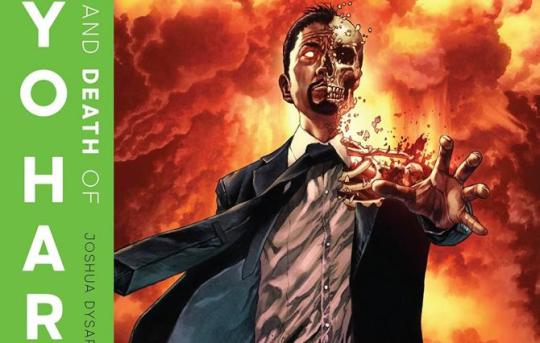
19. The Life and Death of Toyo Harada
Joshua Dysart, CAFU, Andrew Dalhousie & others
I think my favorite villain in all of comics is Toyo Harada? I know that’s a weird statement to make in a universe with a Jonathan Hickman-written Magneto in stores and a Jonathan Hickman-written Doom on my shelf, but there’s a big difference between good big-2 bads and Harada: Harada’s right.
read more: The Best TV Episodes of 2019
Harada’s goal is to push humanity to a utopia. He’s extremely down on the current construct of global governance, so his methods are decidedly authoritarian, but his diagnosis of the problem and his end goal are both 100% correct, and that makes him a fascinating villain. And this book, created by the people who helmed most of the flagship books of the first wave of Valiant comics since it returned in 2013, feels like a way to close off that chapter by putting Harada back in a box for a little while. Every issue of this series has CAFU doing present-day art and an all-star guest (Doug Braithwaite, Adam Pollina) drawing flashbacks to earlier periods in Harada’s life. It looks fantastic. And it reads great: Harada is every bit the manipulative bastard he’s been since the first Harbinger book rolled out years ago.
read The Life and Death of Toyo Harada on Amazon

18. Coda
Simon Spurrier, Matias Bergara, Michael Doig
God, what a gorgeous comic Coda is. Matias Bergara is well on his way to stardom because of it, and it’s well deserved.
Coda is a story about a marriage falling apart, set against a high fantasy backdrop where a catastrophe stripped the world of almost all of its magic. Over the course of its 12 issues, it morphs from a fairly stock fantasy comic with flashes of brilliance in its relationships, into a story about stories that manages not to climb up its own ass and perch on some intestinal pretense. The last quarter of the story is elegant, sweet and earnest, and more than makes up for some dragging in its middle.
read more: The Best Movies of 2019
What keeps the story moving through that middle, and what lands it so beautifully, is Bergara’s stunning art. It’s more mad and inventive than what the story implies, but bright and clear all the same. It’s almost like early period Chris Bachalo but with modern production values. When I first thought this, my inner monologue said it in a hushed whisper, like it was blasphemy. But the further into the book I went, the more confident I was in the assessment. Coda is a moving story that’s also one of the best looking comics of the year.
read Coda on Amazon
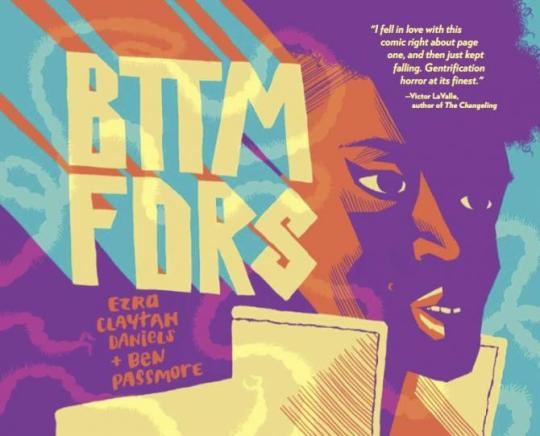
17. BTTM FDRS
Ezra Claytan Daniels (W), Ben Passmore (A) Fantagraphics
True story: I was about a third of the way through BTTM FDRS and I sat down with a goal of reading 15 or so more pages. I stood up 40 minutes later having ripped through the last 200 pages of the comic, and regretted it from about five different angles. You'll hit a point where you won't be able to put it down. It’s a terrific horror story.
BTTM FDRS is transparently a story about how awful gentrification is. Two hipsters move into an old industrial building in a not-quite-yet up and coming neighborhood, and they’re pretty shitty. They meet a neighbor, a theme rapper who dresses in colonial gear and calls himself Plymouth Rock. And then they all get trapped in their new haunted house, one that’s full of environmental and body horror.
On its surface, BTTM FDRS is extremely not subtle. One of the gentrifiers is wearing one of those hideous 80s cyclist hats that says “RAP” on the bottom of the upturned brim. But at the same time, the horror components of the book are much more subtle about the overall theme. I don’t want to spoil it too much, but the monster ties into the gentrification idea very nicely. Passmore does a great oozing monster and outstanding terrified cartoon faces, and the end result is a smart, thoughtful, great looking comic.
read BTTM FDRS on Amazon

16. The Immortal Hulk
Al Ewing (W), Joe Bennett (P), Ruy Jose (I), Paul Mounts (C) Marvel Comics
The Immortal Hulk is easily the best horror book to come out this year. At least the best deliberate horror book, that’s not about gross medical malpractice or the hellscape our world has become. It’s incredibly fun to watch comic creators jump from good but underappreciated to superstars, and to see two creators do it on the same book is even better. That’s what’s happening here: Ewing and Bennett are going from “oh man, how great was Ultimates 2/52” to “holy shit I need to buy everything they do."
There’s a lot to love about Immortal Hulk - the way Ewing juggles so many characters, or how deliberately paced the story and the additions of new gamma characters is. But the best part is how utterly perfect the body horror is. The Rick Jones Abomination monster is the most disgusting thing I’ve seen in comics all year. A grasping hand for a face is somehow grosser than those fish with the human teeth that make a mass extinction an okay tradeoff. The way Hulk’s powers are played as grotesque metamorphoses is the best I’ve ever seen it done, and the slow burn mystery of the gamma world is what makes me rush back to this book every new issue.
read The Immortal Hulk on Amazon
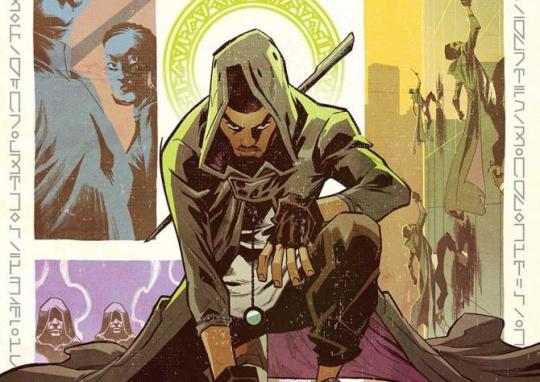
15. Excellence
Brandon Thomas (W), Khary Randolph (A), Emilio Lopez (C) Image Comics
Khary Randolph makes some of the most dynamic, visually entertaining comic art in the business, so you can probably guess how fast I jumped at him doing design work and interiors for a magic story. And it was the right call: Excellence is...well...excellent.
Spencer Dales is the son of a prominent ruling magical family who gets his magic late, and as a result watches his father bond with another kid as he teaches his new mentee how to wield mystical power. If you’re rushing past it, Excellence vaguely resembles Harry Potter, but it's full of resentment and totally different family drama, and the visuals are much flashier. It’s always near the top of my stack to read when it comes out.
read Excellence on Amazon

14. DCeased
Tom Taylor (W), Trevor Hairsine, James Harren & Stefano Gaudiano (A), Rain Beredo (C) DC Comics
I can’t believe this worked. I should have seen it coming - Tom Taylor, DCeased’s writer, was behind a lot of great comics in the last few years, including several (I’m looking at you, Injustice) that just shouldn’t have worked, but did. And yet, I saw “DC Zombies” and I rolled my eyes hard.
I shouldn’t have. DCeased is a gorgeous comic that made me cry at least twice. It does a better job of capturing the essences of pretty much the whole Justice League one by one than most of their solo books do: Batman, Superman, Flash, Black Canary, and Green Arrow all get amazing moments. To do this inside a zombie story is extremely difficult, but Taylor’s script is emotional and incisive, while Hairsine and Gaudiano work magic with the character acting and the horror of the book. It was so good that there’s still a part of me that can’t believe how much I want a sequel.
read DCeased on Amazon

13. They Called Us Enemy
George Takei, Justin Eisinger, Steven Scott (W); Harmony Becker (A) Top Shelf Productions
I’ll be honest, I came into this book not wanting to like it. It’s a non-comics celebrity airdropping into our medium - it felt a little bit like a stunt. But almost as soon as I cracked it open, I was struck by how much emotion Harmony Becker put into her art. George and his siblings are immediately charming and innocent, so when that innocence is stripped away from them by the way my country’s horrific internment of Japanese-Americans hits her, it hit me too, like a wave of shame.
Internment during World War II is one of the most shameful episodes in American history, and even an autobiography that tells that story must walk an incredibly delicate path - too far in one direction, and you’re sugarcoating terror; too far in the other and you drown the reader in sorrow and miss some of the human moments that make the story real. They Called Us Enemy walks that tightrope beautifully: throughout the book, you feel what George and his siblings felt. It’s a good story well told that is shamefully relevant to our world today.
read They Called Us Enemy on Amazon

12. Second Coming
Mark Russell (W), Richard Pace & Leonard Kirk (A), Andy Troy (C) Ahoy Comics
Second Coming is the other Russell book to make the list because this feels like where his comics career has been going the whole time. It’s got the brutal ridicule of modern society that made The Flintstones so amazing, and the incredibly thoughtful take on Christianity that was just beneath the thin veneer of comedy in God Is Disappointed In You. And shockingly, it might also be the nicest comic on the stands.
The hook of the story is exactly what it says on the tin: Jesus is back. Only this time God sent him to live with his brother, obvious-Superman-analogue Sunstar, because he got bullied so hard last time. So Russell, Pace and Kirk are putting a very biblically traditional Christ into a superhero crimefighter story and using both angles to mock (or gently rib, mostly) the other. It is a book that’s obsessed with pointing out how much better it is to treat people with kindness, and it’s really funny about it. Pace handles the God pages, and does everything with a scratchy, inky sketchiness that I love; he does layouts for the Sunstar pages, and Kirk and Troy finish them, and it’s pretty amazing how effortlessly the art goes back and forth between that scratchy 80s indie look and traditional, very good superhero art. Second Coming is a lot of fun to read.
read Second Coming on Amazon
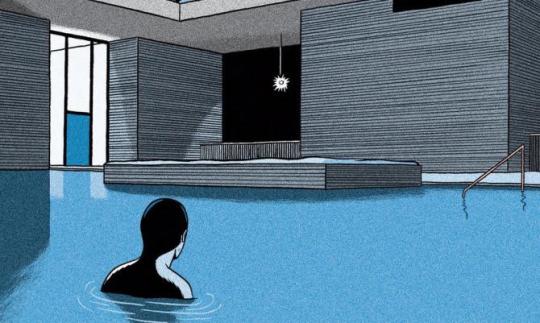
11. Swimming in Darkness
Lucas Harari (W/A) Arsenal Pulp Press
Swimming in Darkness mixes a psychological thriller with a haunted house story, and the result is a haunting, creepy, gorgeous comic that sticks around in your brain far longer than you’ll be comfortable with.
Harari’s story takes main character Pierre, a French student who left school after a nervous breakdown, to the Vals Thermal Baths in the Swiss Alps. The Baths have a legendary architecture, and a myth around them that every hundred years they eat a foreigner. The book is the story of what he discovers while there.
The book is a lot of sitting quietly in weird architecture - it’s all mood and tension, and Harari does a great job with both. The Baths look wonderful, angular and bizarre, and the deliberate pacing goes a long way to making this book so effective.
read Swimming in Darkness on Amazon
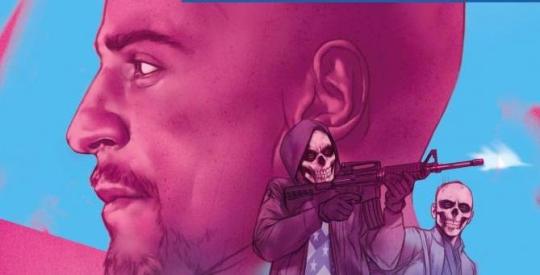
10. American Carnage
Bryan Edward Hill (W), Leandro Fernandez (A)
Vertigo
American Carnage will go down as the last great Vertigo book. It’s just brutal from start to finish.
Hill and Fernandez send Richard Wright, a mixed race ex-FBI agent who can pass as white who was booted from the Bureau for killing a teenager who pulled a cell phone on him, deep undercover to infiltrate the white nationalist army being formed by a California billionaire and his daughter.
This is pure mid-period Vertigo out of the Scalped/100 Bullets mold. Everyone in this comic is an awful person, but they’re all terrible for their own reasons. And of course, there’s nothing even close to a happy ending. Fernandez’s art is a terrific match to the story. He’s loose and sketchy but always tells a clear story. American Carnage was an excellent comic. I hope we get Hill and Fernandez working together again soon.
read American Carnage on Amazon

9. Runaways
Rainbow Rowell (W), Kris Anka (A), Matthew Wilson (C) Marvel Comics
I liked Runaways a lot when it was originally created, but I wouldn’t call myself a dedicated fan. But I binged Rowell, Anka and Wilson’s newest volume, and I was shocked: at how easy they made it to step right into basically an in-progress retcon; at how masterfully Rowell juggles a HUGE cast of characters; and at how much damn fun the book is.
This book is pure teen soap opera. The point of the book is unambiguously the emotions of the characters and not high action and adventure, and Rowell makes each character’s distinct voice so entertaining to track through the melodrama that it’s now one of the first things I read when a new issue hits. Anka does faces and acting deceptively well for such a fashionable artist, and Wilson is, as usual, amazing. Runaways is a great book; you should definitely think about giving the first volume to comic reading friends as a holiday gift.
read Runaways on Amazon

8. The Banks
Roxanne Gay, Ming Doyle, Jordie Bellaire
TKO Studios
The best heist stories are a little bit angry, and Roxanne Gay, Ming Doyle and Jordie Bellaire's The Banks gets a family crew together for some purposeful theft that's amazing fun to read. The book sets three generations of women on a path to a big score that takes down some garbage people, including the man who killed the youngest Banks' grandfather.
The heist is fun and tense, but it's Doyle and Bellaire's artwork, and the relationships between the three generations of Banks women that make this comic so good. Doyle tells a hell of a story: the art is crisp and clean and clear, with wonderful subtelty to the body language and really sharp character designs. Bellaire's colors make the book drip with atmosphere. And Gay and the rest of the team do an outstanding job of building conflict into the leads. You ache with them at the murder of Clara's husband, and you feel the anger when Clara and Celia butt heads. That makes the payoff to the story even better: the deeper into the family dynamic you are, the higher the tension is, and Gay, Doyle and Bellaire do a great job of pulling you in.
read The Banks on Amazon

7. Superman’s Pal, Jimmy Olsen
Matt Fraction (W), Steve Lieber (A), Nathan Fairbairn (C) DC Comics
I’ve already talked at length about what makes Superman’s Pal, Jimmy Olsen so incredible, but I want to bring up one thing I’ve missed: its fundamental compassion. This book is every bit as hilarious and even a little daring for a mainstream superhero book (not often you get a joke at the expense of the internet’s collective foot fetish in a Superman comic), but underneath that, Jimmy Olsen is an incredibly empathetic, compassionate book. Packed in between panels of invisible Jimmy running from monsters and growing tusks at a pie-eating contest, there’s one quick panel of an exhausted, broken Jimmy in full fatigues and bullet proof vest, and Clark looking over his shoulder, worried.
Photography in a war zone is an incredibly dangerous job that kills a lot of real world journalists. To slip that in with Clark as the audience stand in completely changes the nature of the book - Jimmy’s every bit as tough as Lois and Clark are, dedicated to showing people the horrors of war to the point where he puts his own life in grave danger, and the fact that one time he took a shower in pink Kryptonite doesnt’ change that at all. Superman’s Pal, Jimmy Olsen is an amazing, hilarious comic, but it also deeply cares for the Superman universe’s mythos and is adding some great stuff to it.
read Superman's Pal Jimmy Olsen on Amazon
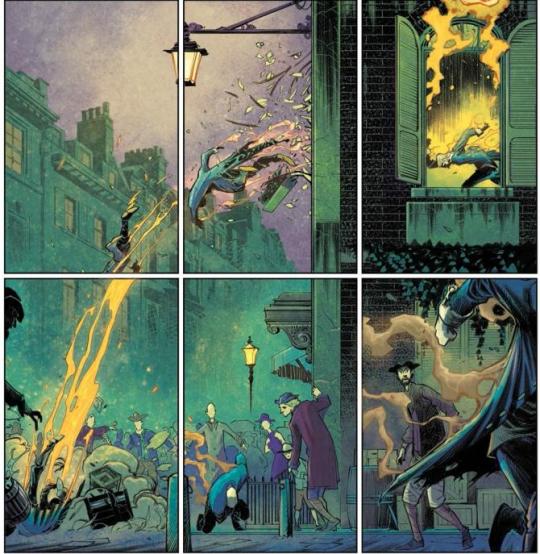
6. These Savage Shores
Ram V (W), Sumit Kumar (A), Vittorio Astone (C) Vault Comics
I’m constantly looking for something I’ve never seen before. Ram V, Sumit Kumar and Vittorio Astone gave me that with These Savage Shores, and they did it with some really impressive technical skill.
These Savage Shores is a period piece about a vampire/demon battle that plays out between London and Calcutta via the East India Company. It manages to be a monster story, a period drama, a monster book and a history lesson all at the same time. Ram V balances each piece of the story delicately and makes it really tough to put down.
Kumar’s art is a huge draw. This is the first work I’ve seen from him, but holy socks it’s terrific. The figures and backgrounds have a very Bilquis Evely/The Dreaming feel to them, but the layouts are spectacular. The way he uses the nine panel grid is simultaneously deliberate and dynamic. Astone’s colors are a perfect pair - London is gray and drab and rainy, while the jungle outside Calcutta is close and sticky and warm. It’s phenomenal work.
read These Savage Shores on Amazon

5. Assassin Nation
Kyle Starks (W), Erica Henderson (A)
Image Comics
Kyle Starks is great. He’s absolutely hilarious, and fills his writing with a surprising amount of heart and an overwhelming amount of imagination. But if we’re being completely honest, the guy who wrote Sexcastle is maaaaybe not the most subtle comic talent out there. But to be honest, I didn’t realize that subtlety would improve his work until I saw Erica Henderson do it for him, and the resulting comic, Assassin Nation, is brilliant and one of my favorites from either creator.
The book is about the world’s greatest assassins - all ranked according to skill and kill counts - and a set up that’s causing them to be picked off in large numbers. It’s jammed with jokes of every kind - sight gags, satire, inane absurdism (Fuck Tarkington is the breakout character of 2019). Henderson is an absolute wizard. She’s such a good storyteller that I’ll read anything she does, with any writer and any characters. I knew Assasin Nation would be good when I heard about it, but I had no idea how great it would turn out.
read Assassin Nation on Amazon
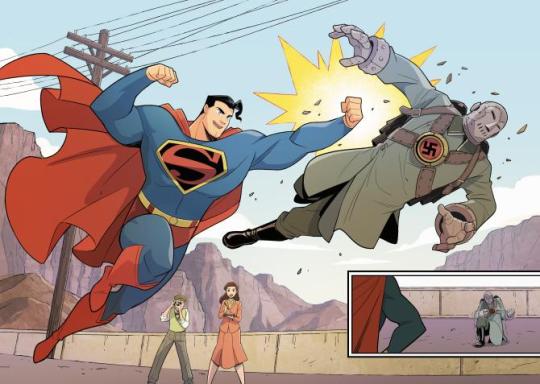
4. Superman Smashes the Klan
Gene Luen Yang (W), Gurihiru (A) DC Comics
Gene Yang is one of the best writers working in comics. He’s thoughtful and diligent about his characters, which lets him get deep inside their heads and flesh them out fully, both through their actions and how he poses them in the story. And he took an old Superman tale - Superman Smashes the Klan is based on a story from the old radio show - and made a couple of tweaks to it to turn it into one of my favorite character studies of Superman and Clark Kent that I’ve ever read.
By putting Roberta and Mrs. Lee in the story, we get an entirely different point of entry to the tale, and two new point of view characters to look at Superman through the immigrant experience. I still don’t want to spoil anything, more because I won’t be able to relay the elegant simplicity of the statement the same way the text does, but it recast, for me, Clark Kent’s existence specifically in a way that makes my whole relationship with Superman as a character richer.
Gurihiru is the perfect art team to pair with Yang on this. They make Superman accessible and welcoming, but intimidating and obviously super at the same time. This is a great Superman story told well, and exactly what I want out of the character.
read Superman Smashes the Klan on Amazon

3. House of X/Powers of X
Jonathan Hickman (W), Pepe Larraz/R.B. Silva (A), Marte Gracia (C) Marvel Comics
There’s probably not much more that I can say about HoXPoX that I haven’t already said. The “two series that are one!” were everything I hoped they would be going in: intricately plotted, skillfully told and wholly different from what came before. I wasn’t expecting career-making work out of Larraz, Silva and Gracia, but their art was so good that people will be holding this run up to everything they do in the future as an incredibly high bar for them to hit again. These 12 issues were the best X-Men comics I’ve ever read as they came out.
I do think the entire experience of HoXPoX changed my expectations from comics. Hickman talked a lot in interviews about giving readers the most bang for their buck, and the care put into every detail on every page made that concern evident. I spent as much time pouring over every page of these comics as I do reading all the rest of my books combined every Wednesday. The data pages were an immersive, interesting way of dropping information on the reader - because they were presented as data collected by the characters, instead of pace-breaking infodumps, they brought you deeper into them. And the internet was legitimately a blast while these comics were coming out. I’ve never actually had fun on Twitter before, but the X-community made this reading experience even better, and a book that wasn’t up to these standards, even if it was still excellent, wouldn’t have inspired that.
read House of X/Powers of X on Amazon

2. Kid Gloves: Nine Months of Careful Chaos
Lucy Knisley (W/A) First Second
Kid Gloves, Lucy Knisley’s half women’s health explainer, half memoir about her pregnancy, was making the list about halfway through the book, when I realized I had ripped through that much of the story in only 20 minutes, and I was retaining just about everything. I knew it was going near the top of the list when I ended the book in tears, muttering “you sue that doctor until he’s dead” at it.
Knisley has a gift for conveying information, and the parts of the book that aren’t memoir are thoroughly researched, deeply informative and entertainingly presented. Parts of it read as a history of women’s health, and parts as an infographic about the current state of it, but all of it will make you mad and want to change things. But the memoir segments are brutally honest about how joyful and shitty and terrifying and mundane pregnancy can be, about how normal the scary parts are and how extraordinary the whole process can be. Kid Gloves was extra real to me because I’m still close enough to my family’s experience where it was like a read along, but her honesty and her cartooning skill make it easy to disappear into her story regardless of what you’re bringing to it as a reader. Kid Gloves was a delight to read.
read Kid Gloves: Nine Months of Careful Chaos on Amazon

1. The Hard Tomorrow
Eleanor Davis (W/A)
Drawn & Quarterly
Eleanor Davis is something else. What she does with pacing and perspective made me feel unlike any other comic I read this year. It’s truly exceptional comic art, and even if you don’t like the politics of the book, you should pick it up. I promise you won’t be able to put The Hard Tomorrow down.
The comic is about Hannah and John, two young lefties living out of a car trying to get pregnant and build their own house. Hannah is a home health aide and a member of a protest group, and John’s a stoner who grows weed and trades it to their handyman for his work. The book follows the two of them through their lives as the cops clamp down on the group, and John gets roped into their handyman Tyler’s Infowars-ish compound.
About two thirds of the way through the book, it starts barreling towards its climax - a bunch of leaders of Hannah’s protest group get arrested, the resulting protest turns into a riot, and the leaders eventually sell the group out to get their families and lives back. Meanwhile, John visits Tyler’s compound and gets subjected to Tyler’s increasingly deranged worries. Hannah gets a call from one of the freed group leaders and told that they’re being hung out to dry, and when that call ends, the panel pulls way back to show Hannah and the woman she’s caring for sitting alone, shocked, from a distance. Two pages later, Tyler tries to convince John to learn to shoot and hands him a gun, and we get a full page splash closeup of the handgun in John’s hand. This is incredible storytelling - Davis starts really building to the climax with this sequence, and it hit me like a violin crescendoing into a string snapping on a minor chord. She does the same thing with the end, slowing time down and using five splash pages almost like a flipbook animatic to hammer home her semi-resolution. The Hard Tomorrow is an incredible piece of comics storytelling, easily the best comic I read this year.
read The Hard Tomorrow on Amazon
Read and download the Den of Geek Lost in Space Special Edition Magazine right here!
facebook
twitter
tumblr
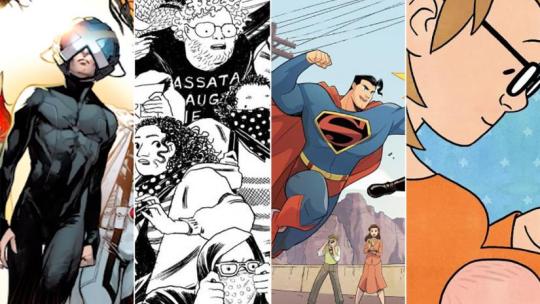
The Lists Jim Dandy
Dec 23, 2019
Mark Russell
DC Entertainment
Valiant Comics
Image Comics
Vertigo
Boom! Studios
IDW Comics
Marvel
from Books https://ift.tt/34Rjuw0
0 notes
Photo

Possible hints of new physics found Global analysis of observables related to rare B decays shows a discrepancy with the Standard Model at five standard deviations An international research team has presented a global analysis of a set of observables related to one type of rare B decays measured in different experiments: mainly LHCb, Belle and also preliminary results from ATLAS and CMS. The result of the analysis considering 30 observables (many of them proposed by this group) showed that the Standard Model is disfavored as a solution to explain all those observables at five standard deviations ("5 sigmas") with respect to a New Physics solution. In direct searches, a 5 sigma discrepancy is conventionally called a discovery. If only observables that test lepton flavor universality are considered, it is found evidence of non-universality in a range between 3 and 4 sigmas. The research team is composed by Sebastien Descotes-Genon, director of the Laboratoire de Physique Theorique (LPT, CNRS, Orsay ); Joaquim Matias, professor at the Universitat Autònoma de Barcelona (UAB) and researcher at the Institut de Física d'Altes Energies (IFAE); Javier Virto, postdoctoral researcher at the Albert Einstein Center for Fundamental Physics (University of Bern); Lars Hofer, postdoctoral researcher at Departament FQA, ICC, University of Barcelona (UB); Andreas Crivellin, postdoctoral researcher at Paul Scherrer Institut (PSI, Villingen, Switzerland); and Bernat Capdevila, PhD student at UAB and IFAE. Rare B decays and New Physics Rare decays are suppressed in the Standard Model (SM) and, hence, they are an excellent place to look for New Physics that can compete with the SM in these decays. Examples are the decay of a B meson into a spin-1 particle called K* and two muons, or that of a Bs meson into two muons. New Physics is a generic way to refer to the more fundamental theory that will supersede the SM. We know that the SM cannot explain several important observations like, for instance, the existence of dark matter or the matter anti-matter asymmetry in the universe. 30 observables in four different experiments An observable is a physical quantity that can be measured and compared with a prediction. For the present global analysis, 30 observables have been calculated and then measured in one or many of the four above-mentioned experiments. The first important step was taken in 2005, in a paper where a new class of observables, going beyond the traditional analyses at the time, and with high potential to observe New Physics, was proposed. Later on, in 2012 and 2013, the group presented a complete set of this class of observables. In 2013, LHCb decided to measure for the first time these observables, and found a 3.7 sigma discrepancy with the SM. LHCb confirmed this tension in 2015 with more data, and, one year later, Belle confirmed also the tension with a result in very good agreement with LHCb. A few weeks ago, at the Moriond conference, ATLAS and CMS presented very preliminary results, ATLAS confirming the anomaly and CMS more consistent with the SM. In the meantime, a long list of other deviations with respect to the SM were measured. One special kind of those deviations comes from two observables called RK and RK*. They are ratios of a B-(B0) meson decay rate into a Kaon (or K*) particle and either muon anti-muon or electron positron pair. They are designed to test one property of the SM, called lepton-flavor universality. Those are extremely clean observables and bring important information. First, they point towards a hint that nature may violate lepton flavor universality and, second, under this hypothesis they are fully consistent with the rest of the observables. Lepton Flavor Universality Lepton flavor universality is a property of the Standard Model that treats all leptons in a democratic way at the level of interactions (with differences in the above mentioned decays coming from the ratios of the lepton masses). This democracy implies that one should expect the measurements of both the RK and RK* observables to be around one, but, instead, they were both measured to be around 0.75. Future Prospects These results open a new research direction, and LHCb is focused on producing and measuring a long list of these kind of observables able to test universality to try to confirm what has been seen in RK and RK*. Some of these new observables might be able to disentangle different possibilities. A possible solution to this discrepancy with the SM predictions would be that we are seeing the first footprints of a new particle, and two possible candidates might be either a Z' gauge boson (similar to the known Z particle but with very different couplings with particles) or a leptoquark. This calls for an explanation in terms of models. Either models containing a Z' particle with very specific couplings (in particular, coupling predominantly to muons over electrons) or models including leptoquark particles. The latter are a generic class of particles that allow leptons and quarks to interact directly and carry color and electroweak charges, and they are naturally embedded in, for instance, grand unification theories.
4 notes
·
View notes
Video
vimeo
Seeing More Dell XPS 13 Onesal collaborated with Elastic in the creation of a series of films for Dell based on exploratory CG simulations to promote the release of their new Dell XPS 13 high-end laptop. Working closely with Director Paul Mitchell, we developed a campaign that illustrates human reactions to content focusing on the human iris, making use of different elements and materials such as hair, sand, and vegetation. Onesal was in charge of doing the research and development and CG through production under the direction of Elastic. Credits: Client: Dell Agency: Y&R Chief Creative Officer: Executive Creative Directors: Fern Cohen, Margot Owett Creative Directors: Elliott Graham Producer: Larissa Ananko Executive Producer: Bobby Jacques Sr. Business Affairs Manager: Maggie Diaz ____________________________________________________________________________ Onesal Team: Design: Damian Sendin, Nahuel Salcedo, Mariano Abel, Fede Kanno Animation: Nahuel Salcedo, Damian Sendin, Mariano Abel, Fernando Cimino Additional Animation: Juan Manuel Isola Simulation Artists: David Albrecht Kvien, Taishi Yagyu, Damian Sendin, Nahuel Salcedo Assitant Simulation Artits: Yu Fujishiro, Alexia Oylataguerre 2D VFX artist: Matias Mastrogiano Laptop Modeling: Juan Martin Miyagi Production: Ailin Brunner, Lucia Gutkin Production Assistant: Ceci Delu ____________________________________________________________________________ Elastic Team: Director: Paul Mitchell Art Director: James Levy Designer: Mert Kizilay Editors: Justine Gerenstein, Kenny Breit, Doron Dor, Fred Fouquet CG Supervisor: Kirk Shintani 2D VFX Artists: Jason Forster, Maciek Sokalski, Kevin Kim, Peter Sidoriak, Stefan Galliot Steven Wolff, Matt Sousa Online Editors: John Valle, Chris Riley, Sam Kolber Producer: Jacklyn Ramirez Pitch Producer: Meredith Cherniack Executive Producer: Luke Colson Head of Production: Kate Berry Managing Director: Jennifer Sofio Hall ____________________________________________________________________________ COLOR Colorist: Paul Yacono Color Assistant: Gabe Sanchez Color Producer: Jenny Bright Executive Producer: Thatcher Peterson ________________________________________________________________________ SOUND Music Company: MachineRoom SoundLounge Final Mix: Alicia Rodgers
0 notes
Text
Reading three week one
The
Sixth
Sense
The Meaning of Atmosphere and Mood
Juhani Pallasmaa
Through its blinkered emphasis on visual form and function, has modernity divorced us from our sense of belonging to the cosmos? What, then, is the secret of creating architecture
that envelops and inspires us? As scientific research increasingly favours the point of view that our unconscious – as opposed to detailed – perception has higher existential value, Helsinki-based architect and professor emeritus Juhani Pallasmaa argues that peripheral vision is key. Only through engagement with this can architects trigger what could be described as our sixth sense – the atmospheric.
126
Joseph Mallord William Turner, Interior of a Great House: The Drawing Room, East Cowes Castle,
c 1830
Turner’s atmospheric interior pulls the viewer into the embrace of the space.
Whether people are conscious of it or not, they actually derive countenance and sustenance from the ‘atmosphere’ of the things they live in or with. They are rooted in them just as a plant is in the soil in which it is planted.
— Frank Lloyd Wright, 19541
Why do we identify with and feel a strong emotional attachment to certain spaces and places, while others leave us cold, or even frightened? Why do we feel like insiders and participants in some spaces, whereas in others we experience alienation and ‘existential outsideness’?2 Is this not because the settings of the first type embrace and stimulate us, make us surrender ourselves to them, and feel protected and sensually nourished, strengthening our sense of reality, belonging and self; whereas alienating and disturbing settings weaken our sense of being?
Guest-editor Matias del Campo introduces this 3 with the following: ‘Instead of perpetuating the techno mantra of computational design, this issue of 3 strives to examine the characteristics of contemporary architectural production in terms of their ability to evoke mood, radiate atmospheric conditions and portray phenomenological traits of the sensual as well as the actual.’ From this point of departure I have chosen to give certain historical and biological perspectives in order to frame the notions of mood and atmosphere in an experientially meaningful context. It is evident that modern and contemporary architectures have turned a blind eye to many of the fundamental sensory and mental issues concerning our relationships with physical settings, both ‘natural’ and man-made. Through modernity, the art of building has gradually focused on the technical, formal and aesthetic concerns of architecture instead of cultivating its inherent relational and mediating characteristics.
Harmony as an Architectural Aspiration
Resonance with the cosmos and a distinct proportional tuning were essential qualities of architecture from antiquity until the instrumentalised and aestheticised construction of the industrial era. The fundamental task of architecture was to create a correspondence between the
127
Tuning the world – harmony of numbers in music and architecture
Pythagoras (570–495 BC) established the relations between number ratios
and sound frequencies.
This woodcut shows him experimenting with bells, water glasses, stretched cords and various-sized pipes. His Hebrew counterpart, Jubal, uses weighted hammers on an anvil. From F Gafuro, Theorica musice, 1472.
Since the beginning of modernity, architectural theory, education and practice have primarily been concerned with the expressive qualities of form and space.
Aulis Blomstedt, Study of Pythagorean intervals applied
to the human scale, undated, late 1950s
Blomstedt connected visual and musical harmonies in
a system of numbers in accordance with Pythagorean principles. He concluded his meticulous studies in the early 1960s in a proportional system that he entitled Canon 60.
128
Jaakko Klemetinpoika Leppänen, Petäjävesi Church, Petäjävesi, Finland, 1764
The intoxicating and haptic atmosphere of an all-wood space.
microcosm of the human realm and the macrocosm of the universe. This was sought through proportionality based on small natural numbers following Pythagorean harmonics. The Renaissance also introduced the competing proportional ideal of the Golden Section. But while during the modern era only a handful of scholars and architects, such as Hans Kayser, Rudolph Schindler, Le Corbusier and Aulis Blomstedt, were interested in proportional harmony as a means of assuring an experiential coherence of architectural works, similar to musical tuning, in today’s consumerist and utilitarian society any aspiration for harmonic attunement of a larger context, or inner harmonic cohesion within the architectural work itself, has been entirely abandoned.3
Since the beginning of modernity, architectural theory, education and practice have primarily been concerned with the expressive qualities of form and space. Form and formal expression have even become synonymous with modernity.
This orientation favours focused vision and the Gestalt principles described in psychological literature. Le Corbusier’s credo ‘Architecture is the masterly, correct and magnificent play of masses brought together in light’, illustrates this visual and formal orientation.4 Studies on vision have been primarily interested in focused perception and static gaze, which, however, are exceptional conditions in the lived reality. It is evident that focused vision necessarily implies outsideness in relation to what is seen. Thus, the fundamental experience of being embraced by space necessarily calls for diffuse and peripheral perception in motion.
It is this omnidirectional, multisensory, embodied and emotive encounter with space and place that makes us insiders and participants. I suggest, therefore, that it is the biased focusing on visual form that is responsible for the weak atmospheric quality and sense of interiority in much contemporary architecture. Architects in the modern era have considered ambiences, feelings and moods as something naive, romantic and entertaining instead of regarding such experiences as necessary constituents of environmental quality. Indeed, it is only recently that atmosphere, mood and attunement have become part of modern architectural theory and discourse.5 Modern thinking
129
has been interested in phenomena that can be consciously observed and rationally analysed, but the experience of mood and feeling does not arise from directed, focused and conscious attention.
Mood seeps into our mental constitution in an unnoticed and unstructured manner, in
the same way that we feel temperature, humidity or the smell of the air, unintentionally and in an embodied manner.
Altogether, mood is closer to an embodied haptic sensation than to an external visual percept.
The atmospheric paintings of Joseph Mallord William Turner, the Impressionists and Abstract Expressionists evoke strong sensations of interiority, tactility and the feel of the skin. The art forms of painting, cinema, literature and theatre, and especially music, have been more aware of the significance of atmosphere, feeling and mood than architects. Some time ago I asked a Finnish composer and a pianist6 about the role of atmospheres in their music. Smiling enigmatically, both answered: ‘Music
is all atmosphere.’ Is this not why music is used in films to create and heighten moods, or to evoke specific tunings and desires in commercial settings? A master novelist’s skill as well as that of the film or theatre director is likewise to evoke, articulate and sustain specific moods in order to create the dramatic flow and continuum of the narrative. Should this not also be the task of the architect?
Visual Elementarism and Embodied Understanding
Modernism has favoured an elementarist view where entities are assumed to arise from elementary units and percepts. However, when we study our perceptions and experiences critically, we seem to be perceiving essences of complex multisensory entities such as the characteristics of spaces, places, landscapes and urban settings in an instant. These perceptions take place even quicker than we become conscious of any details, or even our own active attention. We gaze intentionally at visual objects and events, whereas atmospheres come to us omnidirectionally, similarly to acoustic and olfactory sensations.
We sense the overall mood, tuning, feeling, ambience and atmosphere of a setting before we have become conscious of it, or have identified any of its constituent features. In the process of design, atmospheric qualities also arise unconsciously in an embodied and haptic manner rather than through conscious retinal strategies and intentions. The sense of a coherent experiential entity is evoked by the designer’s
sense of existence and body more than conscious and deliberate visual intentionality.
Atmosphere is certainly closely related with the spirit of place, its genius loci, as well as our empathic and affective capacities. In the same way that music can charge a spatial or social situation with a particular mood, the ambience of a landscape, townscape or interior space can project similar integrating and encompassing feelings. Emotional reactions usually arise vaguely, without any distinct focused object or nameable cause. Love, happiness and hate, for instance, are not objects; they are relationships, moods and states of mind. Similarly, we may never intellectually ‘understand’ a work of art, but it can convey an ineffable influence throughout our entire lives.
‘Understanding is not a quality coming to human reality from the outside; it is its characteristic way of existing,’ argued Jean-Paul Sartre.7 This implies that, contrary to our accepted beliefs, we grasp entities before details, singularities before their components, multisensory syntheses before individual sensory features, and emotive or existential meanings before intellectual explanations. We sense embodied and existential meanings outside of the direct, conscious cognitive channels of our life situations. This exemplifies embodied and tacit knowledge. Yet these processes are
in evident conflict with established perceptual assumptions as well as the
‘Understanding
is not a quality coming to human reality from the outside; it is its characteristic way of existing’ — Jean-Paul Sartre
130
Frank Lloyd Wright, Taliesin West, Scottsdale, Arizona,
1938
Perfect harmony and atmospheric attunement of landscape and architecture.
unquestioned priority given to formal and focused vision and cognitive understanding. Since the Greek philosophers, focused vision has been regarded as synonymous with knowledge and truth. However, neuroscience lends support to the view that we experience entities before elements, and we intuit lived meanings without conceptual or verbal signification. Our atmospheric
sense is clearly an evolutionary priority and a consequence of the activities of our right-brain hemisphere.8
Atmospheric Perception in Evolutionary Perspective
I suggest that we have developed our capacities of judging entities at the edge of our awareness through evolutionary processes. This point is also made by therapist-philosopher Iain McGilchrist.9 It has obviously been advantageous for humans to get the meaning of settings
in an instant in terms of their existential and survival qualities. We have developed, as other animals to various degrees, two independent yet complementary systems of perceiving; one mode of precise focused perception and the second of diffuse and unfocused peripheral scanning.10 Today’s science confirms the assumption that we have these two systems of perception – the conscious and unconscious – and that the first is activated 20 to 30 milliseconds before the latter. According to scholars such as Anton Ehrenzweig, unconscious scanning is also our creative mode of perception.11
131
Alvar Aalto, Säynätsalo Town Hall, Säynätsalo,
Finland,
1952
An emotive, atmospheric image of an Italian hill town concealed in contemporary architecture.
Peter Zumthor, Therme Vals, Graubünden, Switzerland, 1996
Zumthor is one of the internationally known architects today writing about the significance of atmospheres in architecture. His own architectural works project a strong atmospheric quality and cohesion.
132
Notes
1. Frank Lloyd Wright, ‘The Natural House’ [1954], in Bruce Brooks Pfeiffer (ed), The Essential Frank Lloyd Wright: Critical Writings
on Architecture, Princeton University Press (Princeton, NJ), 2010, p 350.
2. Edward Relph, Place and Placelessness, Pion (London), 1986, p 51.
3. For information on proportionality, see: Rudolf Wittkower, Architectural Principles in the Age of Humanism, Academy Editions and St Martin’s Press (London and NewYork), 1988; Alberto Pérez-Gómez, Attunement,
MIT Press (Cambridge, MA
and London), 2016; and Juhani Pallasmaa, ‘Man, Measure,
and Proportion’, Encounters 1 – Juhani Pallasmaa: Architectural Essays, Rakennustieto Publishing (Helsinki), 2012, pp 231–48.
4. Le Corbusier, Towards
a New Architecture, The Architectural Press (London), 1959, p 31.
5.The most recent studies of this subject are the books and writings of Peter Zumthor, Tonino Griffero, Jean-Paul Thibault and Alberto Pérez- Gómez.
6. Composer Kalevi Aho and pianist Minna Pöllänen.
7. Jean-Paul Sartre, The Emotions: An Outline of a Theory, Carol Publishing Co (NewYork), 1993, p 9.
8. See Iain McGilchrist, The Master and His Emissary:The Divided Brain and the Making of the Western World, Yale University Press (New Haven, CT and London), 2009, p 40.
9. Ibid, p 12.
10. Ibid, p 102.
11. Anton Ehrenzweig, The Hidden Order of Art [1970], Paladin (St Albans), 1973.
12. Ibid, p 59.
13. Ibid.
14. Iain McGilchrist, ‘Tending to the World’, in Sarah Robinson and Juhani Pallasmaa
(eds), Mind in Architecture: Neuroscience, Embodiment, and the Future of Design, MIT Press (Cambridge, MA and London), 2015, pp 99–122.
15. Gabriele d’Annunzio, Contemplazioni della morte, Milan, 1912, pp 17–18. As quoted in Gaston Bachelard, Water and Dreams: An Essay on the Imagination of Matter, Pegasus Foundation (Dallas, TX), 1983, p 16.
16. Mark Johnson, The Meaning of the Body: Aesthetics of Human Understanding, University of Chicago Press (Chicago, IL and London), 2007, p 9.
17. See Ehrenzweig, op cit,
p 284.
18. Matti Bergström, Aivojen fysiologiasta ja psyykestä (On the Physiology of the Brain and Psyche), WSOY (Helsinki), 1979, pp 77–8.
19. David Howes (ed),The Sixth Sense Reader, Berg Publishers (Oxford and NewYork), 2011, pp 23–4.
However, precision needs to be suppressed for the purpose of observing
large entities. The mathematician Jacques Hadamard suggested that even in mathematics, the ultimate decision must be left to the unconscious, as a clear visualisation of problems is usually impossible.12 He stated categorically that it is mandatory ‘to cloud one’s consciousness in order to make the right judgement’.13 McGilchrist relates this divided attention with the differentiation of our two brain hemispheres. It is biologically advantageous to be able to make precise and focused observations and general, vague peripheral ones simultaneously, but would this
be impossible within a single system of perception?14 Focused vision detaches
itself from contextual interactions, whereas atmospheric observations fuse and unite all the sensations through the sense of being and self. The omnidirectional senses of hearing, hapticity and smell complement the visual sensations to produce a multisensory existential experience relating us fully with our setting. The experience of atmosphere or mood is thus predominantly an emotive, pre-reflective mode of experience.
Mood and Emotion
The richest experiences happen long before the soul takes notice. And when we begin to open our eyes to the visible, we have already been supporters of the invisible for a long time.15
— Gabriele d’Annunzio, 1912
One reason why peripheric perceptions have been undervalued, or totally neglected, in architecture is that we have not acknowledged that emotions evaluate, articulate and structure our relations with the world.
Emotions are regarded as unconscious, secondary reactions, instead of possessing intentionality and factual value. Yet emotions arise from primal levels of consciousness and, significantly, the first wave of neural signals is always directed to these unconscious systems. As the philosopher Mark Johnson has argued: ‘There is no cognition without emotion ... emotions are not second-rate cognitions; rather they are affective patterns of our encounter with our world, by which we take the meaning of things at a primordial level.’16 There is strong evidence that the unconscious system of perception has a higher existential priority.17 The potential superiority of the unconscious processes in comparison with consciousness is revealed dramatically by the neurological fact that the information-handling capacity of our entire nervous system is estimated to be 1015 times the capacity of our conscious system.18
The nature of vision itself has been grossly misunderstood as something automatic, objective and precise. Research has revealed that the process of
vision is a fragmented and discontinuous mosaic that constantly fuses perceptions with memory and imagination. A visual image itself is composed of separate percepts
of colour, form and movement, received at the temporal distance of 40 to 60 milliseconds. In addition, our focused vision sees what we have learned and
what we want to see, whereas the peripheral system of perception is capable of identifying what is genuinely new. Mood tunes us emotively with our environment, and as a consequence we do not need to continuously and consciously monitor its overwhelming medley of details.
We are not related to our environments only through the five Aristotelian senses;
in fact, The Sixth Sense Reader (2011)19 lists over 30 systems through which we
are connected with the world. I suggest that the atmospheric sense could be named our sixth sense, and it is likely to be existentially our most important. Simply, we do not stop at our skin; we extend our bodily self by means of our senses and our technological and constructed extensions. The elecromagnetic waves of the human heart can now be measured from a distance of 5 metres (16 feet) away, but in principle they extend to infinity. Thus, we unknowingly inhabit the entire universe. 1
Text © 2016 John Wiley & Sons Ltd. Images: p 126 © Photo Adolfo Vera; p 127 Digital image © Tate, London, 2014; p 128(b) © Aulis Blomstedt Estate; p 129 © Photo Kari Hakli; pp 130-31 © Michael DeFreitas North America/Alamy Stock Photo; p 132(t) Courtesy Alvar Aalto Museum, photo Eino Mäkinen; p 132(b) © Hélène Binet
133
0 notes
Text
The Real Culprit in the Central Park 5 Convictions
Netflix reports that 23 million subscribers signed in to watch When They See Us, the mini-series that dramatizes the harrowing experience of the five wrongly convicted young men now known as the Central Park Five.
At least 23 million pundits have published their reactions to the series, too.
Their prescription is straightforward.
First, exorcise from public life the demon prosecutors, Linda Fairstein and Elizabeth Lederer, who supervised and presented the case. Fire them from their teaching jobs; cancel their book contracts.
Second, replace the demons with angel prosecutors.
What could be simpler? The problem is, it won’t work.
The important question raised by all the writing, blogging and podcasting is whether anyone is really serious about preventing a repetition of the tragedies that the series recounts.
Dispensing with Fairstein and Lederer is fine with me. While the going was “good” (that is, when things were moving in the wrong direction for the innocent defendants) both Fairstein and Lederer reached for and basked in the limelight.
But by now the two women have entered a special category of individual—along with, say, Richard III, Eric Trump, and Simon Legree—that we maintain principally to provide the rest of us with a delectable opportunity to savor our own moral superiority.
Putting them aside removes a dangerous distraction.
Systems, Not Devils
To begin with, the notion that Fairstein and Lederer are uniquely evil suggests that the Central Park Five were uniquely victimized. The fact is, the Central Park wrongful convictions were system failures in which many people—cops, defenders, judges, forensic scientists—had a hand, either by making a mistake or failing to catch one.
There was substandard evidence collection work, and there were dangerously outmoded interrogation techniques. There was poor crime scene analysis. Confirmation bias and groupthink characterized the investigation; bureaucratic silos impeded information sharing. A kind of fatalistic lethargy seemed to mark the defense. The specially appointed trial judge took a see-no-evil approach to the prosecution’s case.
And, yes, there was there was an absence of critical thinking by the lawyers directing the prosecution team.
Beyond these frontline deficits, there were the people who hired, trained, supervised, assigned, and funded (or didn’t) the practitioners—the people who created the environment.
Fairstein and Lederer were not swashbuckling renegades in their office; they were respected pros.
As Diane Vaughan said of the Space Shuttle Challenger launch decision, conformity, not deviance, was at the root of the problem. We have to come to grips with the fact that the Central Park Five fiasco was not the work of a pair of sociopaths— not a once-every-30-years lightning strike. These wrongful convictions were very much “normal accidents”.
The shortcuts and “workarounds” that When They See Us makes so clear in hindsight are what we could expect from individuals trying to make sense of their roles under extreme pressure to produce.
And we have to face the reality that the pressure to produce in the Central Park Five case was generated by a public attitude, by the broad societal stereotyping of young black men: a chronic weakness available for exploitation by the Donald Trumps of the world.
In the hysteria following the attack on the jogger, the racially biased coverage set Fairstein and Lederer up as candidates for angel status; it was the innocent defendants who were cast as the devils—or, at least, as Paul Butler points out, the apes.
These features took spectacular form in the Central Park Five case; but the same features are operating to a greater or lesser degree in hundreds of lower temperature, Kalief Browder, cases every month, with Fairstein and Lederer nowhere in sight.
The New Prosecutors’ Challenge
The point of all this is not to mitigate Fairstein’s and Lederer’s mistakes. It is to argue that when Kim Foxx, Larry Krassner, Rachel Rollins, or the other “progressive prosecutors” ride into town on the handsome white stallions issued to them by the commentators, it will be grossly unfair to expect any one of them to deal with all of this by waving a wand.
Reform-minded prosecutors can improve some things by taking action unilaterally within their own offices. They can, for example, raise the internal charging criterion from “probable cause” to “beyond a reasonable doubt.” They can order their staffs to provide open file discovery. They can decide as a matter of policy to avoid steps solely designed to enhance plea bargaining leverage.
For example, they can refuse to seek “trial tax” enhancements to sentences.
They can develop an internal culture that devises sentencing recommendations based on a careful consideration of the community safety implications of failing to address offender substance abuse, mental health, and educational and housing challenges, and that does not default to “longer is better” sentencing posture.
They can recognize that we are heirs to a long and pervasive history of racial bias (both explicit and implicit) and do what they can to train staff to be alert to those issues.
But the criminal justice system isn’t a simple linear, sequential process from crime to conviction. As the Central Park Five experience reveals, criminal justice is an extraordinarily complex environment in which scores of practitioners, in a dozen separate but interacting silos, are attempting to make sense of a cloud of swirling, overlapping, often contradictory influences.
Getting things right requires more than a chivalric individual moral code. It requires collaboration with numerous other practice communities and insight into the working lives of the people within them.
That is why leaders in the earliest generation of “progressive prosecutors” like Milwaukee’s John Chisholm and San Francisco’s George Gascon provided essays to the National Institute of Justice’s volume Mending Justice supporting the idea of all-stakeholders, non-blaming, learning reviews of criminal justice events that can reveal the connections—and the failures to connect—that are endemic to everyday criminal justice life.
Chisholm’s experience in convening a group of 30 stakeholders to learn from the mistaken release of Markus Evans, a Milwaukee juvenile who almost immediately after release killed a teenage girl, showed him that only these all-stakeholders collaborations can reveal the information gaps that prevented anyone with decision-making power to understand fully what was happening.
In effect, all prosecutors are entangled in a system that, as Diane Vaughan observed of the pre-Challenger NASA, embodies a “structural secrecy”: a system that threatens to keep secrets from itself.
This “structural secrecy” will remain a challenge to even the most ambitious prosecutorial reformers, and, paradoxically, it will be a greater challenge as our new data-driven environment generates more and more information.
In a forthcoming article , Andrew Guthrie Ferguson meticulously unpacks the implications of Manhattan District Attorney Cyrus Vance’s innovative “intelligence-driven prosecution” scheme in light of the constitutional requirement that evidence favorable to the accused must be turned over to the defense.
The powerful architecture of centralized data collection which Vance’s approach mobilizes was not designed to identify the exculpatory and impeaching material that prosecutors are required to provide to the defense.
Ferguson’s specific focus is on compliance with the discovery rule requiring disclosure but it seems pretty clear that evidence of innocence can unintentionally (but routinely) be converted into a “weak signal” that inevitably disappears from the screens of the practitioners making the decisions, just as the warnings about the effect of unusually low temperatures on the launch rocket’s “O-rings” on the eve of the Challenger launch faded into the background.
Everyone has some of the information; no one has all of it.
Think about how easily that could happen when an alibi was at issue.
Linda Fairstein has taken a pugilistic attitude toward the current attempts to demonize her, but it is hard to believe that—back then—she would not have welcomed the information about the actual rapist, Matias Reyes, that was somewhere in NYPD files but never foregrounded in the investigation.
James Doyle
Maybe she would have come to the same conclusions. Who knows? But it would certainly have been by a different route, and the odds in favor of accuracy would certainly have been improved.
The issue here is not the bad character of one prosecutor, or the better character of his or her replacement.
The question is not “Who” but “What” can be changed. The next prosecutor will need help with that one.
James M. Doyle is a Boston defense lawyer and author, and a frequent contributor to The Crime Report. He welcomes readers’ comments.
The Real Culprit in the Central Park 5 Convictions syndicated from https://immigrationattorneyto.wordpress.com/
0 notes